- Ebooks & Courses
- Practice Tests

How To Write an IELTS Pie Chart Essay
Using this 5 steps process to plan and write IELTS pie chart essays will help you to achieve high marks in Task 1:
1) Analyse the question
2) Identify the main features
3) Write an introduction
4) Write an overview
5) Write the details paragraphs
In this lesson, we’re going to work thorough each step as we answer a practice question and I want to start by highlighting the importance of steps 1 and 2. It is essential that you learn how to do this planning stage properly if you hope to write a high-scoring essay.
Before we begin, here’s a model essay structure that you can use as a guideline for all IELTS Academic Task 1 questions.
Ideally, your essay should have 4 paragraphs:
Paragraph 1 – Introduction
Paragraph 2 – Overview
Paragraph 3 – 1 st main feature
Paragraph 4 – 2 nd main feature
We now have everything we need to begin planning and writing our IELTS pie chart essay.
Here’s our practice question:
The chart below shows the reasons why people travel to work by bicycle or by car.
Summarise the information by selecting and reporting the main features, and make comparisons where relevant.
Write at least 150 words.
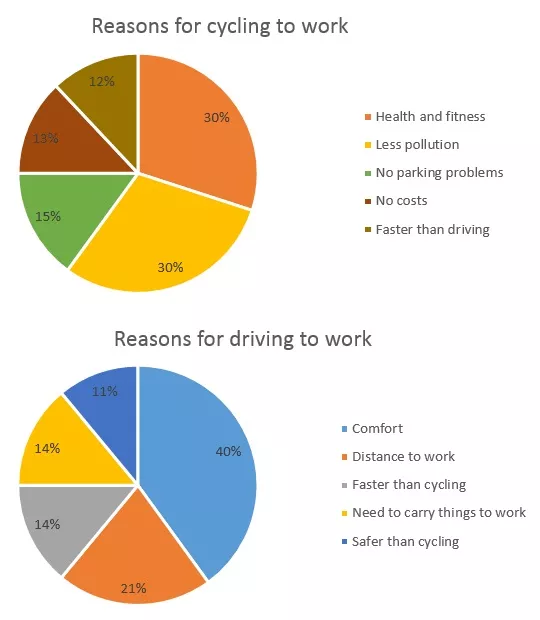
Source: Official website IELTS Essentials
Step 1 – Analyse the question
The format of every Academic Task 1 question is the same. Here is our practice question again with the words that will be included in all questions highlighted .
The chart below shows the reasons why people travel to work by bicycle or by car.
Every question consists of:
- Sentence 1 – A brief description of the graphic
- Sentence 2 – The instructions
- The graphic – chart, graph, table, etc.
Sentence 2 tells you what you have to do.
You must do 3 things:
1. Select the main features.
2. Write about the main features.
3. Compare the main features.
All three tasks refer to the ‘ main features ’ of the graphic. You do not have to write about everything. Just pick out 2 or 3 key features and you’ll have plenty to write about.
Step 2 – Identify the Main Features
The graphic in IELTS pie chart questions should not be difficult to interpret. Each question has been created to test your language skills, not your mathematics ability.
Pie charts always show percentages or proportions. Apart from that, they are essentially the same as bar charts and line graphs in that they are a way of presenting data visually.
All you are looking for are the main features. These will usually be the easiest things to spot. There will be lots of information in the graphic to help you identify them.
Here are some useful questions to ask?
- What are the units of measurements?
- What are the time periods?
- What can you learn from the title and any labels?
- What is the most obvious trend?
- Are there any notable similarities?
(I give more detail on how to use these questions, plus downloadable checklists for identifying the main features of all 7 different types of IELTS Academic Writing Task 1 questions, in the lesson on How To Understand & Analyse Task 1 Questions .)
Pie charts generally have titles and labels or sometimes a key instead of segment labels as in our practice question. The key explains what each segment of the pie chart represents.
So, what information is contained in the two pie charts?
Here's our IELTS pie chart again.

They show two different methods of travelling to work and illustrate the reason why people choose these types of transport.
What main features stand out?
There are 2 main features in these IELTS pie charts:
Main feature 1: The largest proportion of people who cycle do so for health and environmental reasons.
Main feature 2: The highest percentage of people who drive do so because it’s comfortable.
Another notable feature is that the only reason included in both pie charts – that the method is faster – shares almost the same proportion for both modes of transport.
We may not have space to cover this final feature but we’ll note it just in case we need it to make up the words.
The key features you select will be the starting point for your essay. You will then go on to add more detail. However, with just 20 minutes allowed for Task 1, and a requirement of only 150 words, you won't be able to include many details.
We’re now ready to begin writing our essay. Here’s a reminder of the 4 part structure we’re going to use.
Step 3 – Write an Introduction
In the introduction, you should simply paraphrase the question, that is, say the same thing in a different way. You can do this by using synonyms and changing the sentence structure. For example:
Introduction (Paragraph 1):
The two pie charts display the key reasons why people choose to either cycle or drive to work by percentage.
This is all you need to do for the introduction.
Step 4 – Write an Overview (Paragraph 2)
In the second paragraph, you should report the main features you can see in the pie charts, giving only general information. The detail comes later in the essay. You should also make any clear comparisons you spot.
Here are the ones we picked out above. I’ve added the additional feature as it will fit well in the overview.
Main feature 3: For an almost equal proportion of people, their chosen method is the fastest.
Now form these ideas into two or three sentences with a total of around 40 words. State the information simply, using synonyms where possible. No elaborate vocabulary or grammar structures are required, just the appropriate words and correct verb tenses.
For example:
Overview (Paragraph 2):
The largest proportion of people who cycle, have made this choice for health and environmental reasons whilst the prime advantage of driving to work is considered to be the comfort of travelling by car. Notably, for an almost equal proportion of people, their chosen method is the fastest.
Step 5 – Write the 1st Detail Paragraph
Paragraphs 3 and 4 of your IELTS pie chart essay are where you include more detailed information about the data in the graphic. In paragraph 3, you should give evidence to support your first key feature. Don’t forget to make comparisons where relevant.
Here is our first main feature again:
Main feature 1: The largest proportion of people who cycle do so for health and environmental reasons.
And this is an example of what you could write:
Paragraph 3 :
T aken together, health and fitness and less pollution are reasons given by over half of all people who prefer travelling by bike. Each represents a 30% portion which is double the next most popular reason which is a lack of parking issues at 15%.
Step 6 – Write the 2nd Detail Paragraph
For the fourth and final paragraph, you do the same thing for your second key feature.
I’ve added the third main feature again as it will round off the essay well. In an exam situation, I would include it if I had time.
Here’s an example of what you could write:
Paragraph 4 :
A different set of concerns has affected the decision of those who choose to commute by car. Comfort is by far the most significant factor at 40% of people, but distance to work is a more important concern for just over a fifth of drivers. For 14% of people, a faster journey time is the key factor compared to a figure of 12% of cyclists who find their means of transport quicker.
I just want to say a quick word about verb tense in this sample essay. Since there is no time frame given in the question, you could use either the present simple tense or the past simple tense. I've used the present simple tense. Whichever tense you choose, remember to be consistent throughout your whole essay.
Here are the four paragraphs brought together to create our finished essay.
Finished IELTS Pie Chart Essay
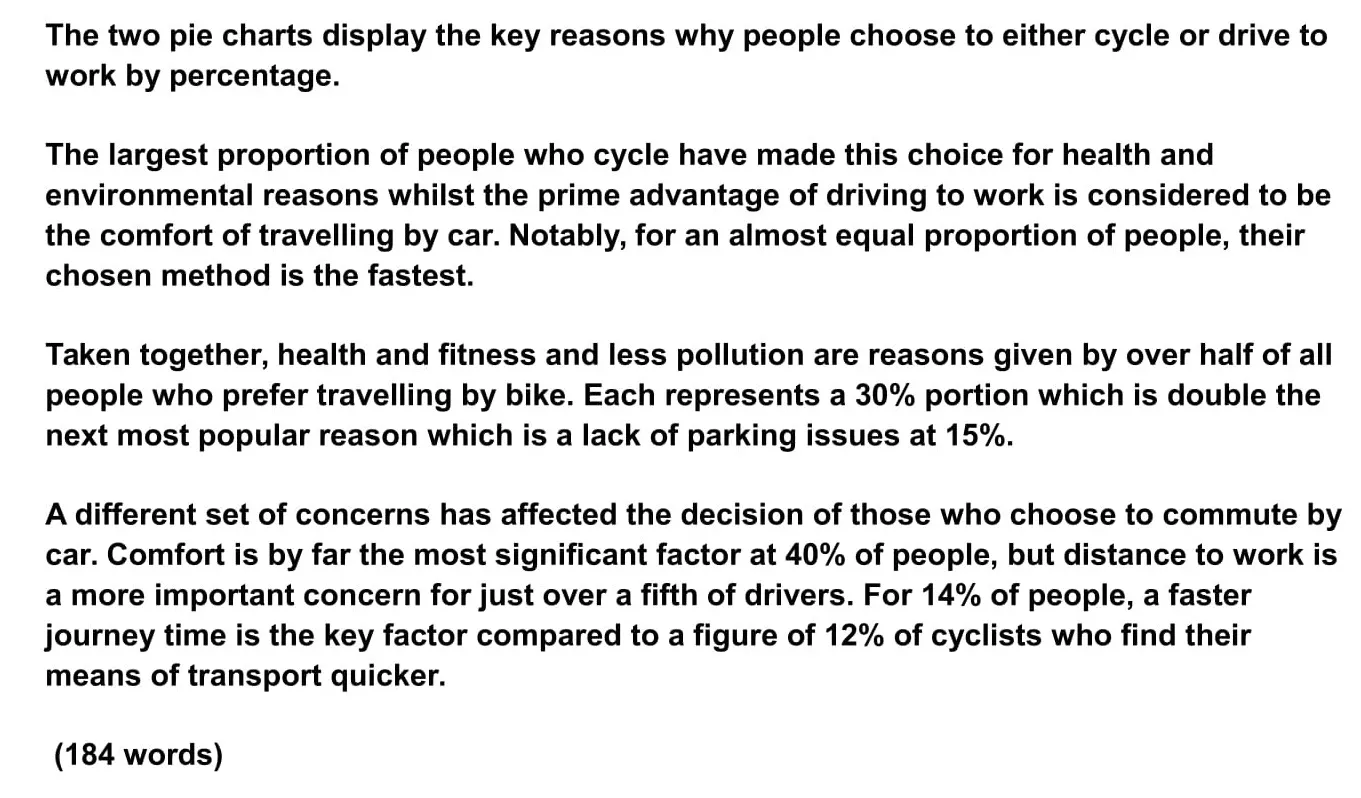
This sample IELTS pie chart essay is over the minimum word limit so you can see that you don’t have space to include very much detail at all. That’s why it is essential to select just a couple of main features to write about.
Now use what you’ve learnt in this lesson to practice answering other IELTS pie chart questions. Start slowly at first and keep practicing until you can plan and write a complete essay in around 20 minutes.
Want to watch and listen to this lesson on how to write an IELTS Pie Chart essay?
Click on this video.
Would you prefer to share this page with others by linking to it?
- Click on the HTML link code below.
- Copy and paste it, adding a note of your own, into your blog, a Web page, forums, a blog comment, your Facebook account, or anywhere that someone would find this page valuable.
Like this page?
Ielts academic writing task 1 – all lessons.
IELTS Academic Writing – A summary of the test including important facts, test format & assessment.
Academic Writing Task 1 – The format, the 7 question types & sample questions, assessment & marking criteria. All the key information you need to know.
Understanding Task 1 Questions – How to quickly and easily analyse and understand IELTS Writing Task 2 questions.
How To Plan a Task 1 Essay – Discover 3 reasons why you must plan, the 4 simple steps of essay planning and learn a simple 4 part essay structure.
Vocabulary for Task 1 Essays – Learn key vocabulary for a high-scoring essay. Word lists & a downloadable PDF.
Grammar for Task 1 Essays – Essential grammar for Task 1 Academic essays including, verb tenses, key sentence structures, articles & prepositions.
The 7 Question Types:
Click the links below for a step-by-step lesson on each type of Task 1 question.
- Table Chart
- Process Diagram
- Multiple Graphs
- IELTS Writing
- IELTS Pie Chart
- Back To Top
* New * Grammar For IELTS Ebooks

$9.99 each Full Set Just $ 23.97
Find Out More >>
IELTS Courses

Full details...

IELTS Writing Ebook

Discount Offer
$7 each Full Set Just $ 21

Find out more >>
Testimonials
“I am very excited to have found such fabulous and detailed content. I commend your good work.” Jose M.
“Thanks for the amazing videos. These are ‘to the point’, short videos, beautifully explained with practical examples." Adari J.
"Hi Jacky, I bought a listening book from you this morning. You know what? I’m 100% satisfied. It’s super helpful. If I’d had the chance to read this book 7 years ago, my job would be very different now." Loi H.
"Hi Jacky, I recently got my IELTS results and I was pleased to discover that I got an 8.5 score. I'm firmly convinced your website and your videos played a strategic role in my preparation. I was able to improve my writing skills thanks to the effective method you provide. I also only relied on your tips regarding the reading section and I was able to get a 9! Thank you very much." Giano
“After listening to your videos, I knew I had to ditch every other IELTS tutor I'd been listening to. Your explanations are clear and easy to understand. Anyways, I took the test a few weeks ago and my result came back: Speaking 7, listening 9, Reading 8.5 and Writing 7 with an average band score of 8. Thanks, IELTS Jacky." Laide Z.
Contact
About Me
Site Map
Privacy Policy
Disclaimer
IELTS changes lives.
Let's work together so it changes yours too.
Copyright © 2024 IELT Jacky
All Right Reserved
IELTS is a registered trademark of the University of Cambridge, the British Council, and IDP Education Australia. This site and its owners are not affiliated, approved or endorsed by the University of Cambridge ESOL, the British Council, and IDP Education Australia.
Search form
Writing about a pie chart.
Look at the pie chart, exam question and sample answer and do the exercises to improve your writing skills.
Instructions
Do the preparation exercise first. Then read the text and do the other exercises.
Preparation

Check your writing: gap fill
Worksheets and downloads.
What devices do you use to go online?

Sign up to our newsletter for LearnEnglish Teens
We will process your data to send you our newsletter and updates based on your consent. You can unsubscribe at any time by clicking the "unsubscribe" link at the bottom of every email. Read our privacy policy for more information.

25,000+ students realised their study abroad dream with us. Take the first step today
Meet top uk universities from the comfort of your home, here’s your new year gift, one app for all your, study abroad needs, start your journey, track your progress, grow with the community and so much more.

Verification Code
An OTP has been sent to your registered mobile no. Please verify

Thanks for your comment !
Our team will review it before it's shown to our readers.

- Study Abroad Test Prep /
IELTS Pie Chart Task 1: Step-By-Step Guide to Describe Pie Charts in IELTS, Best Tips, Sample Answer
- Updated on
- Dec 16, 2023

The IELTS Academic Writing section throws individuals a unique challenge: the Pie Chart Task. This task requires students to write a well-articulated report based on visual information presented as pie charts. Students must not only analyze and decipher the data within but also use their critical thinking skills and mental agility to formulate answers based on their assessment. It’s a true test of both English language proficiency and sharp thinking on your feet. Read the article to delve deeper into the intricacies of the Pie Chart Task.
This Blog Includes:
Step-by-step guide to describing pie charts in ielts writing task 1, best tips to score better in the pie chart task of ielts writing 1, ielts pie chart task sample answer.
Writing Task 1 of the IELTS exam requires describing pie charts in a concise report based on your analysis of the provided information. To ensure a well-articulated and concise answer, first familiarise yourself with the structure of the given task and what it entails. Refer to the following steps to write a well-articulated answer.
Start by Writing a Clear and Precise Introduction:
- Paraphrase the given information at the top of the pie charts.
- Interpret the given data by using your analytical prowess to write a clear and concise report.
- Don’t be tempted to merely copy the data; instead, use your linguistic skills to decipher the information and paraphrase it in your own language.
- Remember, brevity is your ally, so craft your introduction with care, ensuring it entices the examiner to delve deeper into your insightful analysis.
Highlight the Key Features of the Pie Chart in the Overview Section:
- After you are done writing the introduction, you’ll need to highlight the most salient features of the pie chart in the overview section.
- Go through the data multiple times before meticulously noting down all the important features that arise in your mind. Weave all the features together into a cohesive and comprehensible narrative.
- Don’t let any detail remain in the shadows; distill every observation into a clear and concise overview.
Write Information-Dense Body Paragraphs
- The body paragraphs form the heart of your pie chart analysis, carrying the most weight in your report. Here, you’ll segregate the data with precision, crafting two distinct narratives.
- Carefully divide and condense the information, ensuring each paragraph tackles a unique aspect of the pie chart.
- Don’t shy away from specifics. For example, delve into the nuances of slice A in one paragraph, then illuminate the insights hidden within slice B in the next.
- Remember, each body paragraph is its own mini-puzzle piece, fitting seamlessly with the others to build a complete picture of the data.
The pie chart task of IELTS writing may seem daunting to some at first; however, with prior preparation and practice, it’ll be a piece of cake for you to ace it. That being said, here are the best tips to help you score better in this task.
- Be a Data Sleuth : Don’t just stare at the slices; look for the clues in them! Identify, compare and extrapolate as much data as you can from the given information. Always ask yourself the hows and whys to the reason behind the shown percentages. Once you’ll start asking yourself such questions, it’ll be much easier for you to navigate through the given information and create a cohesive response.
- Create a cohesive structure : It is imperative to articulate your observations into a clear, precise and comprehensive structure that is not only information dense, but also easy to read and understand. You must segregate your body paragraphs to convey distinct aspects of the given information.
- Work on your English vocabulary and grammar: Doing so will help you conquer the task of describing a pie chart. Ensure incorporating as much as pie chart language, such as ‘comprises of, represents and accounts for,’ as possible whilst describing a pie chart in IELTS writing. Other than that, you can make your report more interesting by using nouns, vivid verbs, and apt adjectives.
Here is a sample answer for the IELTS pie chart task. Go through them to understand how to describe a pie chart in the IELTS writing task 1.
Ans: The pie charts represent the ratio of the five major types of energy production in France in 1995 and 2005.
Overall, both years witnessed that gas and coal were the major contributors of energy, with a cumulative percentage of more than 50%. On the contrary, nuclear and other energy sources contributed the least amount of energy in both these years. It can be also inferred that France witnessed a minimal change in energy production in this decade.
Coal produced around 29.80% of energy in 1995 which slightly increased to around 30.93% in the year 2005. Similarly, even gas showed a marginal improvement in energy production in France between 1995-2005. In 1995, Gas in France contributed to around 29.63% of energy production, which grew marginally to 30.31% in 2005.
Nuclear power plants in France during the years 1995 and 2005 contributed to around 5% of growth in energy production whilst petrol saw a decrease in production, i.e., from 29.27% in 1995 to 19.55% in 2005.
So, that was all about the IELTS Pie Chart. This task can be challenging for some, but with prior practice and understanding of its structure and nuances, you can easily ace the task with flying colours. We hope the blog could have helped you answer your queries regarding the topic.
How to solve pie chart questions in IELTS?
You can write IELTS pie chart essays by analysing the given information, discerning the salient features of the data, writing a crisp and solid introduction, a to-the-point overview section and detailed body paragraphs.
What vocabulary is used in the pie chart questions in IELTS?
Some of the most common vocabulary used in pie chart questions in IELTS are per cent, percentage, proportion, amount, share etc.
What is the scoring range of IELTS writing?
The scoring range of IELTS writing is 0-9.
Visit the Leverage Live page of Leverage edu or contact our study abroad experts at 1800-57-2000 to strengthen your scores and application to secure your spot in your dream college.
Shubham Das
Shubham Das has been working as an educational content writer for the past two years and has a background in filmmaking & screenplay/ teleplay writing. He is fascinated by the human psyche, literature and cinema.
Leave a Reply Cancel reply
Save my name, email, and website in this browser for the next time I comment.
Contact no. *

Connect With Us
25,000+ students realised their study abroad dream with us. take the first step today..

Resend OTP in

Need help with?
Study abroad.
UK, Canada, US & More
IELTS, GRE, GMAT & More
Scholarship, Loans & Forex
Country Preference
New Zealand
Which English test are you planning to take?
Which academic test are you planning to take.
Not Sure yet
When are you planning to take the exam?
Already booked my exam slot
Within 2 Months
Want to learn about the test
Which Degree do you wish to pursue?
When do you want to start studying abroad.
January 2024
September 2024
What is your budget to study abroad?

How would you describe this article ?
Please rate this article
We would like to hear more.
Have something on your mind?

Make your study abroad dream a reality in January 2022 with
India's Biggest Virtual University Fair

Essex Direct Admission Day
Why attend .

Don't Miss Out
- IELTS Scores
- Life Skills Test
- Find a Test Centre
- Alternatives to IELTS
- General Training
- Academic Word List
- Topic Vocabulary
- Collocation
- Phrasal Verbs
- Writing eBooks
- Reading eBook
- All eBooks & Courses
- Task 1 Lessons & Tips
- Ielts Pie Chart
How to Write an IELTS Pie Chart
This lesson will provide you with tips and advice on how to write an IELTS pie chart for task 1.
To begin, take a look at the pie chart below, and then answer the quiz questions.
If you prefer or if you want extra tips you can also view this lesson in a video ( but don't forget afterwards to do the quizzes on this page that give you the language practice ! ):
You should spend about 20 minutes on this task .
The pie charts show the main reasons for migration to and from the UK in 2007.
Summarise the information by selecting and reporting the main features and make comparisons where relevant.
Write at least 150 words.
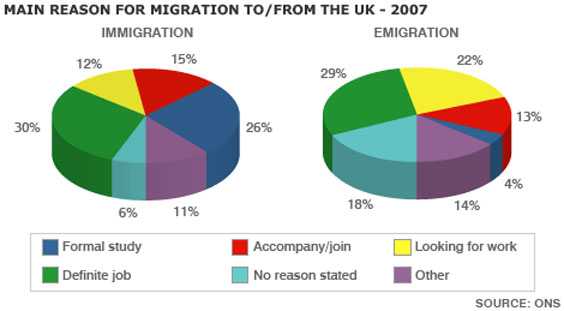
Answer these questions about the IELTS pie chart:
Now take a look at a model answer:

The pie charts illustrate the primary reasons that people came to and left the UK in 2007. At first glance it is clear that the main factor influencing this decision was employment.
Having a definite job accounted for 30 per cent of immigration to the UK, and this figure was very similar for emigration, at 29%. A large number of people, 22%, also emigrated because they were looking for a job, though the proportion of people entering the UK for this purpose was noticeably lower at less than a fifth.
Another major factor influencing a move to the UK was for formal study, with over a quarter of people immigrating for this reason. However, interestingly, only a small minority, 4%, left for this.
The proportions of those moving to join a family member were quite similar for immigration and emigration, at 15% and 13% respectively. Although a significant number of people (32%) gave ‘other’ reasons or did not give a reason why they emigrated, this accounted for only 17% with regards to immigration.
(173 words)
Choose the most important points to write about first
These will usually be the largest ones. As you can see in the model answer, definite job, looking for work , and formal study were all written about first, in order of importance, as these are the main reasons that were chosen for moving.
Items such as ‘other ’ are usually less important and account for small amounts, so can be left till the end.
Make it easy to read
When you write a task 1, you should always group information in a logical way to make it easy to follow and read.
With an IELTS pie chart, the most logical thing to do is usually to compare categories together across the charts, focusing on similarities and differences, rather than writing about each chart separately.
If you write about each one separately, the person reading it will have to keep looking between the paragraphs in order to see how each category differs.
Vary your language
As with any task 1, this is important. You should not keep repeating the same structures. The key language when you write about pie charts is proportions and percentages .
Common phrases to see are " the proportion of… " or " the percentage of… "
However, you can also use other words and fractions. These are some examples from the model answer:
- A large number of people
- over a quarter of people
- a small minority
- A significant number of people
- less than a fifth
This table presents some examples of how you can change percentages to fractions or ratios:
You can improve your flexibility in using these words or test your knowledge of them in this percentage and proportions quiz .
If the percentages are not exact as above, then you can use qualifiers to make sure your description remains accurate. Here are some examples:
This table presents some examples of how you can change percentages to other phrases:
The words above are interchangeable, though number is for countable nouns and amount is for uncountable nouns .
You can practice or test yourself with the language used to approximate figures in this online quiz .
More Task 1 Academic Lessons:
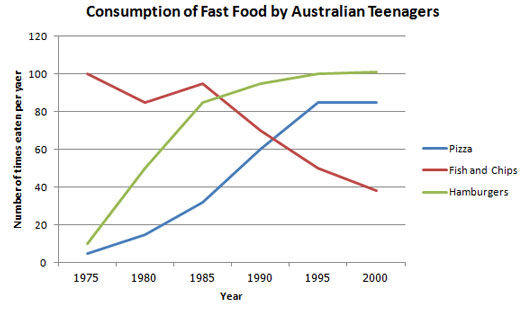
Describing IELTS Graphs: Tips to avoid a common mistake
IELTS Graphs: A common mistake In IELTS graphs is to get the subject of the graph wrong. This lesson explains how this mistake is made and show you what you need to do to avoid it. There is a also a practice exercise.
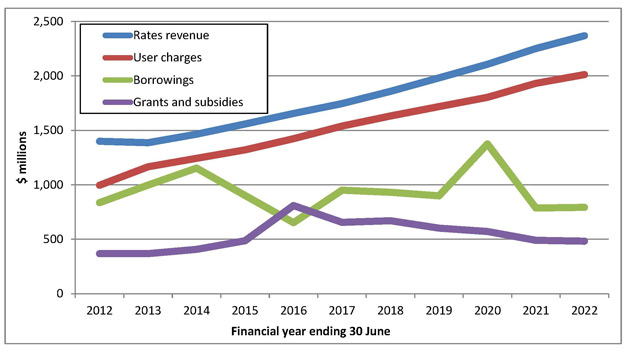
Writing Tips for a Graph in the Future in IELTS Academic
Graph in the future: Sometimes graphs in IELTS refer to a future time. You must know the language to write about these. In this lesson, learn how to write about an IELTS graph in the future. Getting the tenses right is an important part of the IELTS writing task 1.
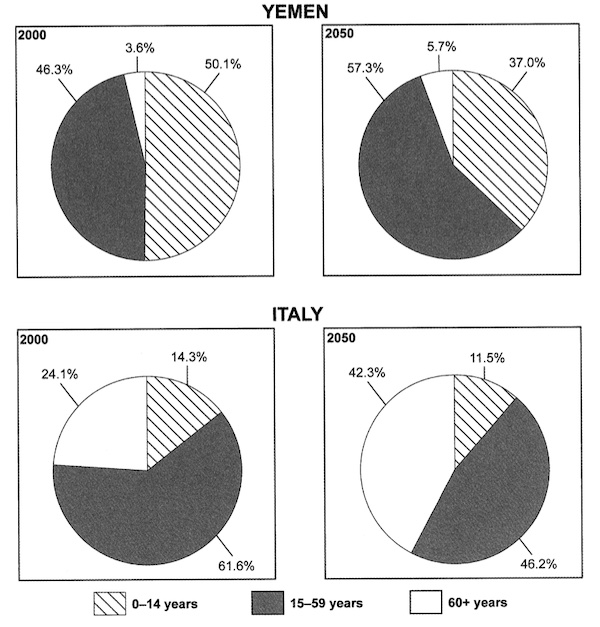
Task 1 Pie Chart: Using the past and future tenses
Task 1 pie chart for IELTS with model answer and tips on how to develop a high-scoring response to this type of chart. You need to use past and future tenses.
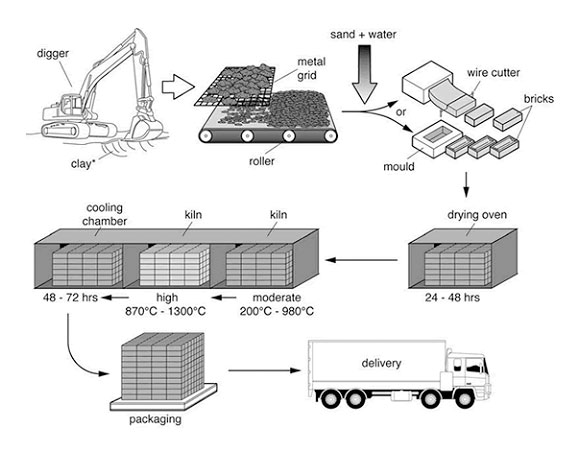
IELTS Process Diagram Strategies and Tips
IELTS Process Diagram: In task 1 of IELTS writing you usually have to describe some kind of graph or chart. But sometimes you get a process. It is therefore crucial that you know how to do this. This easy to follow lesson explains how.
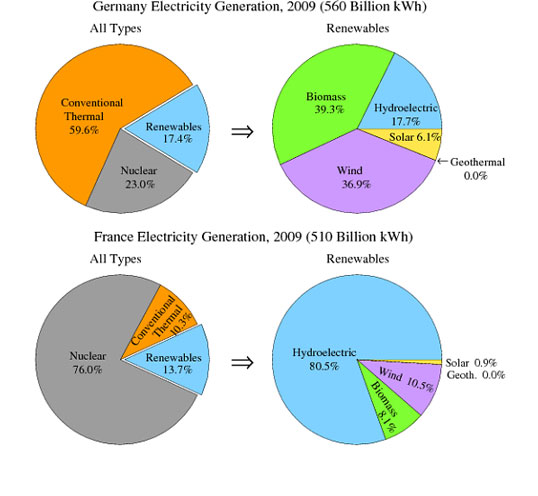
IELTS Pie Chart Exercise: Improve your language flexibility
With this IELTS pie chart exercise you can Improve your language and grammar for writing about Task One charts. The focus is on comparing and on 'proportions'.
How to Describe an IELTS Academic Writing Task 1 Graph
IELTS Academic Writing Task 1: This lesson describes in a simple way how you should describe a graph for the academic part of the test for task 1. You need an introduction, overview and body paragraphs. These simple steps will show you how, and how to get a high score.
IELTS Sample Pie Chart: Describing four pie charts together
View a sample pie chart for the IELTS test on electricity generation, with a model answer. In a pie chart you have to use language connected to proportions and percentages.
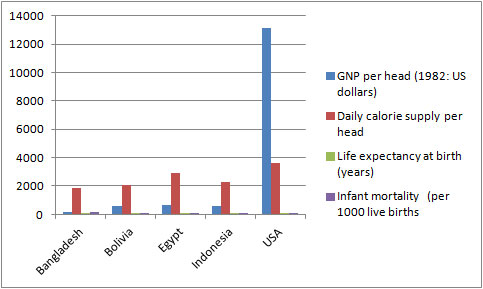
IELTS Table: Tips and techniques for a high score.
IELTS Table advice for a high score. Learn how to describe an IELTS table, which is just another way to present data.
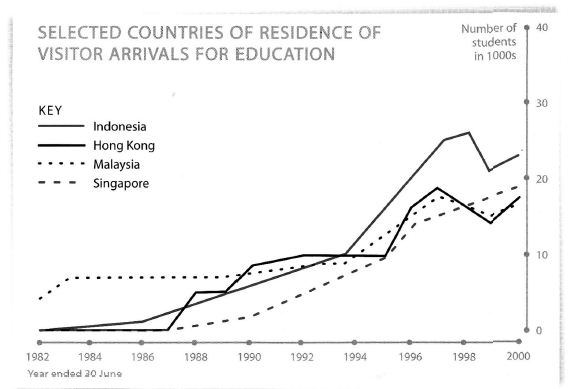
Tips for Organising an IELTS Line Graph
Organising an IELTS Line Graph - This lesson shows you have to improve the coherency of your graph in order to achieve a high band score.
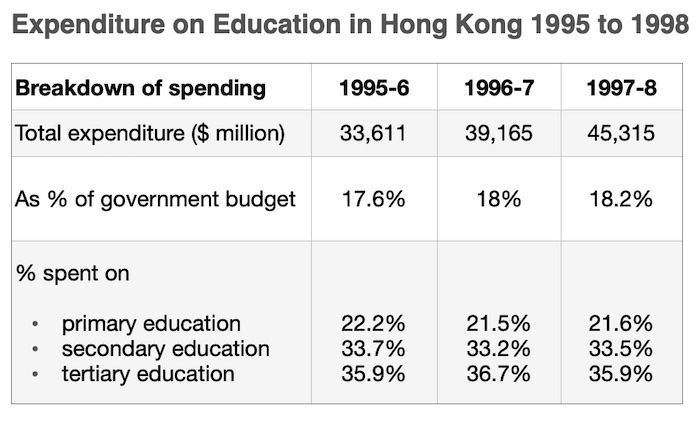
Describing Graph Trends Using the Language of Change
Describing graph trends: In IELTS you must know how to describe the trends that you see in the graph you are given. This lesson provides practice with some common language used to describe trends.
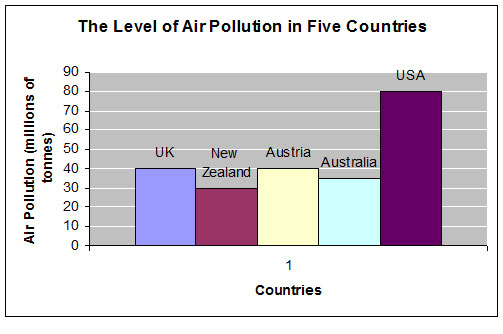
Learn Compare and Contrast Language for IELTS Graphs
Compare and Contrast Language: In the academic IELTS task 1, you have to know the right language if you want to get a band 7 or higher. Practice your IELTS language for bar charts in this task 1 writing lesson.
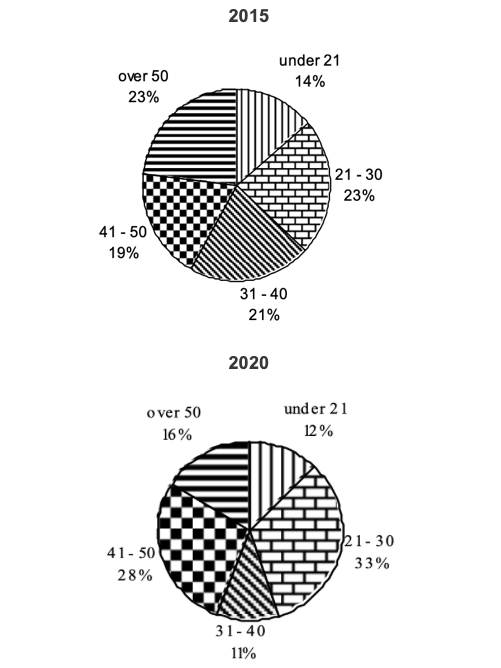
Writing Task 1 Pie Chart: Describing two pie charts over time
Writing Task 1 Pie Chart: This sample chart compares the structure of a company in terms of the ages of the workforce.
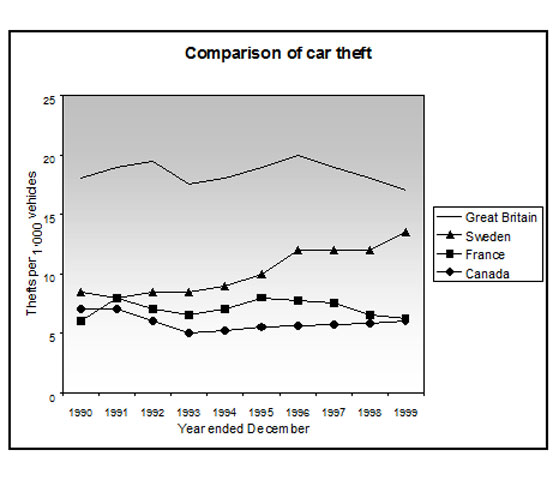
Prepositions in Graphs Quiz: Between; from; to; at; of; in; with; by
Prepositions in Graphs: Practice using prepositions in the IELTS test. View a model answer and practice using a gap fill.
Which Tenses for IELTS are the Most Important?
Candidates often ask which tenses for IELTS are needed in order to do well in the exam. This lesson goes through the grammar tenses and how they apply to the test.
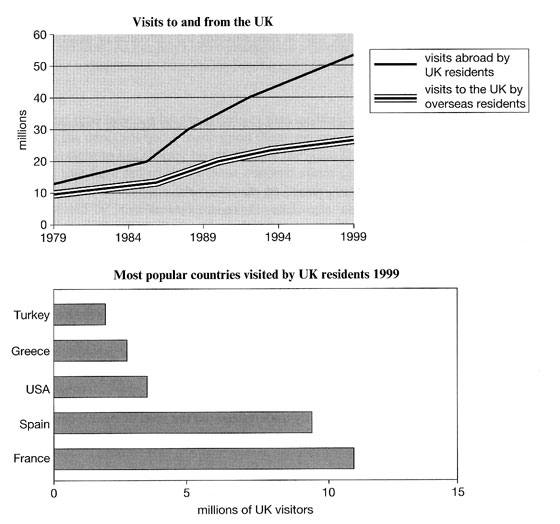
IELTS Bar and Line Graph: How to describe two graphs together
This Bar and Line Graph example shows you how you can write about two charts together in the IELTS test for task 1, with strategies and techniques.
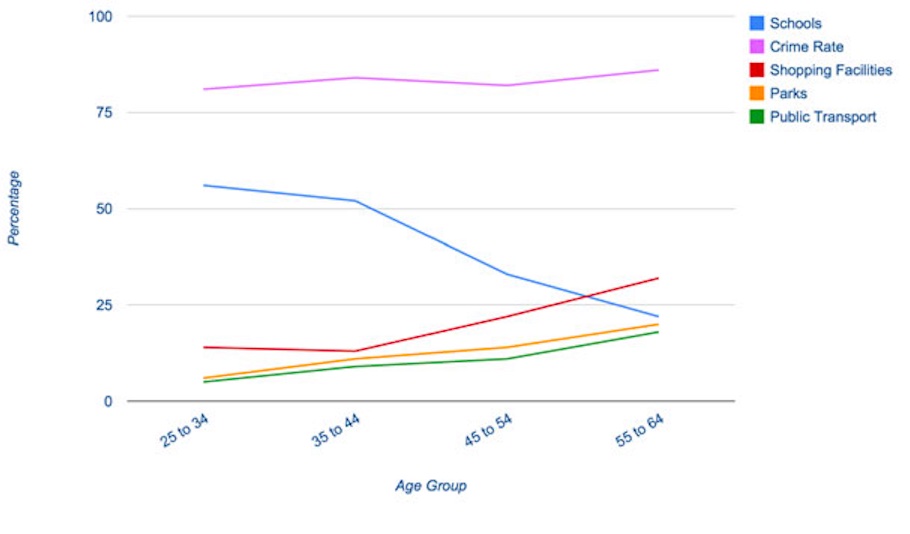
IELTS Task 1 Line Graph Structure Using Groups
For an IELTS Task 1 Line Graph there are different ways to organise your answer. Grouping information is a good way to get a logically structured response.
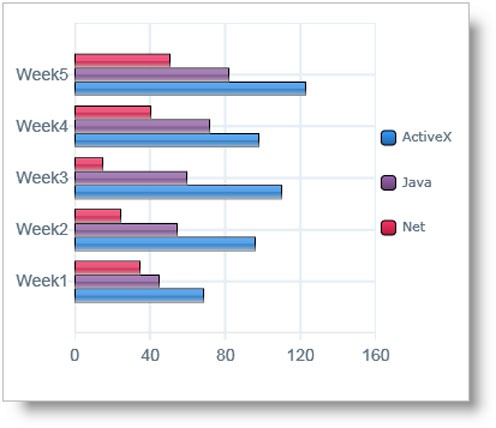
Describing an IELTS task 1 graph over time
This lesson shows you how to write an IELTS task 1 graph or chart that is over time.

Take an IELTS Quiz to test your IELTS knowledge
IELTS Quizzes to test and train you on the writing task and task 2 of the IELTS test. Gap fills and multiple choice.
Any comments or questions about this page or about IELTS? Post them here. Your email will not be published or shared.
Before you go...
Check out the ielts buddy band 7+ ebooks & courses.

Would you prefer to share this page with others by linking to it?
- Click on the HTML link code below.
- Copy and paste it, adding a note of your own, into your blog, a Web page, forums, a blog comment, your Facebook account, or anywhere that someone would find this page valuable.
Band 7+ eBooks
"I think these eBooks are FANTASTIC!!! I know that's not academic language, but it's the truth!"
Linda, from Italy, Scored Band 7.5

IELTS Modules:
Other resources:.
- All Lessons
- Band Score Calculator
- Writing Feedback
- Speaking Feedback
- Teacher Resources
- Free Downloads
- Recent Essay Exam Questions
- Books for IELTS Prep
- Useful Links

Recent Articles
Decreasing House Sizes Essay
Apr 06, 24 10:22 AM

Latest IELTS Writing Topics - Recent Exam Questions
Apr 04, 24 02:36 AM

IELTS Essay: English as a Global Language
Apr 03, 24 03:49 PM

Important pages
IELTS Writing IELTS Speaking IELTS Listening IELTS Reading All Lessons Vocabulary Academic Task 1 Academic Task 2 Practice Tests
Connect with us
Copyright © 2022- IELTSbuddy All Rights Reserved
IELTS is a registered trademark of University of Cambridge, the British Council, and IDP Education Australia. This site and its owners are not affiliated, approved or endorsed by the University of Cambridge ESOL, the British Council, and IDP Education Australia.
- Skip to main content
IELTS Podcast
Pass IELTS with expert help.
How to describe Pie charts for IELTS
Home » IELTS Academic Task 1 » Pie chart for IELTS
In this IELTS Writing Task 1 tutorial, you’ll learn different ways to structure and describe a pie chart for IELTS .
We will talk about the best language to use and teach you how to structure your writing task to get the best results in your IELTS exam .
How to structure your writing task for academic task 1 – pie chart IELTS
To help with your IELTS preparation we will give you a step by step guide on how to structure your pie charts description to receive great results on your writing task 1 exam.
Remember that in IELTS writing task 1, your task is to summarise the main features and make comparisons where relevant. There are several tricks to help you do this.
Step 1 – Prepare
- Let’s start with selecting and reporting the main features of the pie chart. What does the pie chart show? Can you quickly think of any synonyms? Write these words under the IELTS pie chart diagram.
- Look for the biggest and smallest sections of your pie charts – What do they represent? What is the percentage?
- Make a quick analysis – note down the period of time, dates and measurements.
- See the big picture, avoid getting lost in the details. After all, this is a summarizing task.
- When you are confident you have selected the main features, carry on to step 2.
Step 2 – Organise your findings into two groups
When organising the information into two separate groups focus on these topics for your pie charts:
- Major trends
- Major groups
- Group information
- Other similar ideas
Note – you do not have to find examples for all these. The point is that by organising information into groups, you are doing two things at once; reporting the main features (two main trends) and you can also make comparisons where relevant (one group is bigger than the other).
A trend could be that over time, students at the University of Cambridge always spent the most money while students at the British Council spent the least. Another trend could be that one category started out the least popular and became the 2nd most popular by the end of the period studied.
Step 3 – How to organise your paragraphs
Structure everything into this four-paragraph model
Here we have focused on the language we need when we see 2 or more pie charts to compare. The other issue is organization, how to structure and sequence our answer. Here are a couple of ideas:
How many paragraphs do we need – one paragraph is never enough. In fact, we are encouraged to write in paragraphs. Decide on a simple paragraph structure – there’s only 20 minutes for this. The best is the traditional “introduction”, summary “body”, structure with the main “body” part divided into two or three body paragraphs. Overall, you must write at least 150 words.
- Paragraph 1: In your essay introduction, write one sentence explaining what the graphs show. You can paraphrase the title. Example: Pie Chart title: Holiday destinations chosen by Welsh people 1955-2005. Your first sentence: The pie chart shows the vacation preferences of Welsh people over a fifty-year period starting in 1955 and finishing in 2005.
- Paragraph 2: In paragraph 2, you should talk about the information that you identified in step 2. This paragraph should focus on the first group. However, it’s good to include half a sentence if you can compare the first group to other data. For example; Consumers in Sweden, who spent more than twice as much in total than any other country…. follow with more detail about Sweden.
- Paragraph 3: Talk about the information that you have separated in step 2. This paragraph should focus on the second group. For example; In contrast, Belgian shoppers, who spent the least of any group… follow with more detail about Belgian shoppers.
- Paragraph 4: Two sentences summarising your description. (What are the major overall trends, changes, etc.)
Tips for interpreting pie charts in IELTS
We will begin by giving you some general tips for interpreting a pie chart in your IELTS academic writing task.
These tips are good to keep in mind from the moment you take the first look at the pie charts given to you, to the moment you finish your writing task 1:
- If you cannot compare the information on your pie charts, don’t panic. In such a case giving a summary of each picture is fine. Make comparisons where relevant. Take a look at our tutorial on how to compare pie charts here .
- Avoid giving personal opinions at all costs. ( E.g . If the graph shows rising prices and you know it’s because of a war in the Middle East, do not say anything. Your personal opinion must not be mentioned.)
- Always pay attention to the time frame of your pie charts and use the appropriate tense (past, present or future).
- Focus on getting all of the appropriate data from the pie charts/graphs into your writing.
- These are quick tips, if you are still struggling you should consider enrolling in an online course to prepare for IELTS.
- For pie chart interpretation examples and model essays, click here .
Vocabulary for IELTS Pie Charts
Now that you have an understanding of how to structure your description of pie charts and graphs for IELTS writing task 1, let’s talk about the language you should use.
One of the EASIEST WAYS to make sure you ‘make comparisons where relevant’ is to use superlatives: the biggest, the smallest, the largest, the most expensive, the least expensive.
Every superlative you use is an automatic comparison.
Using referencing (which, it, that) helps you summarise the information and if you think carefully you can also include a superlative – potatoes, which were the most expensive type of root vegetable in 2019…
Here are a few examples of good wording for the largest section of your pie charts:
- It is clear that ____represents the largest portion of _____, whereas _____ is undoubtedly the smallest.
- Sales of _____ stood at __% in 1925, which is the majority of_____.
- (If the percentage is around 60%) – Nearly a third…
- (If the percentage is around 52%) – Over a half of all respondents…
Here are a few examples of good wording for the smallest section of your pie chart:
- A small fraction…
- Exactly 30% of students…
- (If the percentage is around 25%) Roughly a quarter of respondents
- … whereas sales for _____ were just 10% .
- In 1955 approximately three quarters were ____, whereas in 1960 this had fallen to just under a fifth.
Written forms of percentages and fractions look like this:
- a half, 50%, 1/2,
- a third, 33%, 1/3,
- two thirds, 66%, 2/3,
- three quarters, 75%, 3/4,
- a quarter, 25%, 1/4
Which tense should you use to describe pie charts in IELTS?
These are the two basic rules you should follow:
Check the graph title, and the pie chart subtitles, look for dates!
– if the year is before the present year (i.e. 2020), use the past tense – if the year is after the present year (i.e 2025), use the future tense – if there is no year, use the present simple tense.
Check you don’t accidentally switch the tense halfway through.
Sometimes you will get charts and graphs that will require you to use more than one tense, but do this deliberately and with caution.
For a more in-depth tutorial about tenses check out this page: 126 IELTS academic task 1 – What tense?!
A great tip to improve your answer when you are writing about past tense pie charts is to START your body paragraphs with fixed expressions in the present tense then switch to the past tense. For example:
The data shows that between 2000 and 2003, there was a significant decrease in the number of…
In contrast, it is evident that in the following year, sales of bread plummeted….
Model Answer for a Pie Chart
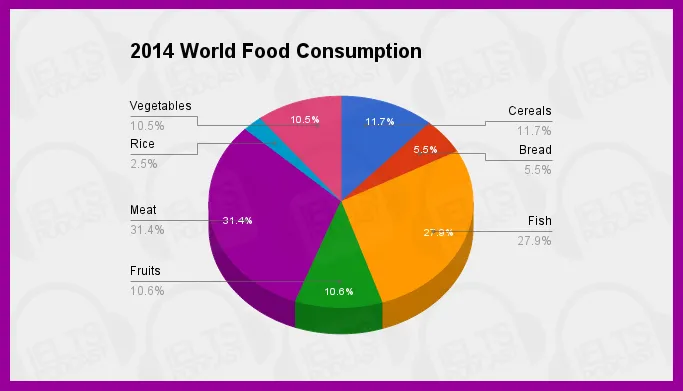
This pie chart shows the shares of total world food consumption held by each of seven different food types in 2014.
Meat is consumed the most, at 31.4 per cent. Fish has the second-highest consumption levels, at 27.9 per cent. Cereals consumption represents 11.7 per cent of the total. Fruits’ share of consumption is 10.6 per cent, followed closely by vegetables at 10.5 per cent, and then bread at 5.5 per cent. The smallest food group in terms of world consumption is rice, at 2.4 per cent.
The graphs show that overall global consumption is widely dispersed among food types; no one type has a majority share. Animal-based foods (meat and fish) do make up the majority of consumption when added together. It is important to note, however, that based on the information in this pie chart no conclusions can be drawn about the dietary diversity of an individual person.
How to compare two pie charts
The language to compare two pie charts
Summarising two pie charts for an IELTS academic task 1 needs careful preparation. Here, I am going to focus on deciding the language we need because if we use the correct language, then we have a good chance to obtain a high band score .
Now we need to handle the language of percentages and proportions and, of course, the language we need will vary according to the topic and content of the pie charts. That is one reason why it is vital to study the title and any sub-headings of the charts.
Pie chart review
Take this example and decide what type of language we will need to describe it.
Naturally, we need in the first place language to describe proportions . Some keywords are:
- per cent (correctly spelt as two words)
At the same time, we must be able to use the language of comparison – to say which country had the largest and smallest share etc. Some keywords here are:
- largest/smallest
- greater/smaller
Two pie charts: related topics, one-time frame (pie chart comparison)
For two pie charts on a different topic and the same time frame you need to use the language of proportion and comparison
Usually, task 1 will not be just one pie chart to describe but two or maybe more. This might involve two pie charts related in terms of “opposition” but static in the sense that both refer to the same time frame, normally a year. Look at the following which presents for the year 2018 the principal European Union trade partners in terms of food and drink: the first chart concerns export partners and the second, import.
In this case, what kind of language do we need?
Of course, we still need the same language of proportion and pie chart comparison.
The major difference is the need to compare two pie charts, comparing exports with imports, making the task more complex.
Two pie charts: one topic only at different times
For two pie charts on a related topic and in a different time frame, you need to use the language of proportion and comparison and change
Now, look at these pie charts. There are of course similarities with the first set. We will always need language to describe proportions and to compare items.
This set refers to agricultural exports from the USA to Cuba in 2005 and then in 2014. In other words, we have just one topic shown over time.
Therefore, we need to use language describing change and trends.
This may be more complex because we have to handle all of the following:
- proportion language – to describe percentages
- comparison language – to describe the biggest and the smallest
- trend language – to describe what changes over time
VIDEO: IELTS Writing Academic Task 1 – How to Describe a Pie Chart
Some final practical advice
- Do not start writing before giving yourself enough time to think. First, decide the language you will need in your answer. Give yourself 5 minutes to look, think and plan.
- Study the charts carefully: the titles for example to check if they deal with the same or connected topics.
- Check the time frames very carefully in the charts and plan how time differences will affect your choice of verb tenses.
Frequently Asked Questions (FAQs)
How to write a pie chart in ielts task 1.
Try to divide the information into two groups. Focus on trends and exceptions for an easy way to do this. Think of synonyms for the keywords and most important numbers – for example, 20% is a fifth.
How do you describe a pie chart vocabulary?
Superlatives (the most, the largest, the smallest) combine description with the comparison which is crucial for a good score. Referencing (which, that, it) is a good way to paraphrase and demonstrate that you can write complex sentences.

How do you write a report on a pie chart?
Follow the 4 paragraph model. First, summarize the question. Second, talk about the first group of data. Third, the other group of data. Fourth, write a summary with the overall trends and patterns. Be sure to use the correct tense.
More useful IELTS Academic Task 1 lessons
- Academic Task 1 Sample Essays
- IELTS Writing Task 1 Vocabulary List With Examples
- Bar Chart IELTS
- How to describe a map
- Describe an image
- Describe a natural process
- How to describe a table
- How to paraphrase
- Line graph sample answer
- Marking criteria for Task 1
- Map vocabulary for IELTS Task 1
- How to describe a flow chart
- Essential skills for Task 1
- How to get band 9 for academic task 1
- How to describe a process diagram
- Academic task 1: sentences and grammar to describe a chart
- IELTS Task 1 Sample Answer 2 Double Graph Pie Chart and Bar Chart
How to Answer Pie Chart Essay in IELTS Writing Task 1 Academics
- IELTS Writing Academics Task 1
Pie chart is one of the major questions in IELTS academic writing task 1.
Under this, you are expected to write your answer as a response to the pie chart presented. Here, you are required to describe the information given in 150 words in 20minutes. To score well in the pie chart essay questions, you need to study the question well.
Solving the pie chart essay questions is all about finding the right keywords in the questions and framing your answer based on them.
To help you with the Pie chart essay preparation, we will walk you through a complete overview of how to answer the Pie chart questions in IELTS Writing Task 1 Academics through this step-by-step guide.
Most of the IELTS aspirants share questions like-
What is a pie chart and how to answer a pie chart essay in the IELTS Writing task 1 Academics?
How to describe a pie chart sample?
Let’s begin by first thing first!
What is a Pie chart essay?
In the academic task 1 writing module, you are asked to write an essay based on visual information or data. This visual information can be presented in the form of a pie chart.
A pie chart is a circular statistical graphic, which is divided into slices to illustrate percentage or numerical proportion. In a pie chart, the arc length of each slice is proportional to the quantity it represents.
While writing a pie chart essay, you have to mention the most significant information. You need to write a short descriptive report in 150 words based on the visual information. You can frame your answer by describing the largest share in the pie chart and contrasting it with the smallest one.
What are the different parts of a Pie chart?
The different parts of a pie chart are-
- Part 1- It is a short explanation of the pie chart
- Part 2- Directs you what to do with the given information
- Part 3- it is the graphic information
Format for describing IELTS Pie Chart Writing Task 1
While writing a pie chart essay, you need to walk by a specific format which is-
- Introduction: Paraphrase the question
- Overview: In the overview, you can describe the trend or write a general overview of the main groupings
- Body paragraph 1: write about the specific logical details of the first grouping
- Body paragraph 2: Write about the specific logical details of the second grouping
You can follow either type of structure for your essay.
Focus on the following topic to organize your findings:
- Major trends
- Major groups
- Group information
- Other similar ideas
Marking Criteria of the IELTS Writing test
There are 4 parameters that you need to fulfill for scoring the desired band score:
- Task Achievement
- Coherence and Cohesion
- Lexical resource and vocabulary
- Grammar Range and Accuracy
Each criterion has a 25% weightage.
How to plan IELTS Writing Task 1-Academics? 1. Analyze the question Read the question; understand the context, instructions, facts, figures, and the axis information for answering the question.
2. Identify the main features Always pick 2-3 trends for forming the answer to your question.
3. Brainstorm the ideas and the vocabulary After identifying the main features, focus on framing and organizing the ideas to answer your question. Stress upon using the right vocabulary that befits the context of the pie chart essay question.
For writing the introduction, you can paraphrase the question and write the overall summary of the text as an overview.
Detailed paragraph : You can decide to elaborate on the main features from point 2 for explaining your point.
Sample question and Answer Here is a sample question and answer for a better understanding of the pie chart essay:
Here the answer reveals the main features of the questions, comparisons , and the overall estimation of the data.
Common Mistakes which you need to avoid in Pie chart Essay writing Incomplete Analysis of the data It is important to go through the question properly to frame your answer. Writing an explanation of the data Don’t write hypothetical reasons for the change in the percentage or the figures. Write according to the data given. Not writing an overview Missing out on writing an overview can cost you a score. Therefore, never be in hurry to complete the question and submit, take time in writing the complete overview. Writing / mentioning each detail Avoid mentioning every detail in the question and focus on including the main trends in the answer. Exceeding the word limit It is a wise man‘s saying that “do what is asked to do”. Going in length won’t fetch you extra marks. Staying and answering the questions within the word limit is crucial to skip on losing marks. Illogical structure In the IELTS Pie Chart Essay writing, you need to follow a specific structure to answer your questions. Do not get diverted from your point and follow the right structure. Not planning before writing Planning forms the base for your answer which is why you need to plan the things before to avoid confusion and wasting of time.
So, in this way you can plan your pie chart essay answer and gain the desired score. Always remember to follow a specific pattern for answering your questions and keep a tab over the tense and vocab to b used in the essay.
Unlock IELTS with Richa aims at providing a detailed explanation of how to attempt pie chart essay questions in IELTS writing task 1 academics and the common mistakes to avoid while answering the questions. For more interesting videos, you can subscribe to Unlock Ielts with Richa on YouTube.
Get Free Ebook
Enroll for Free Last Day Strategies
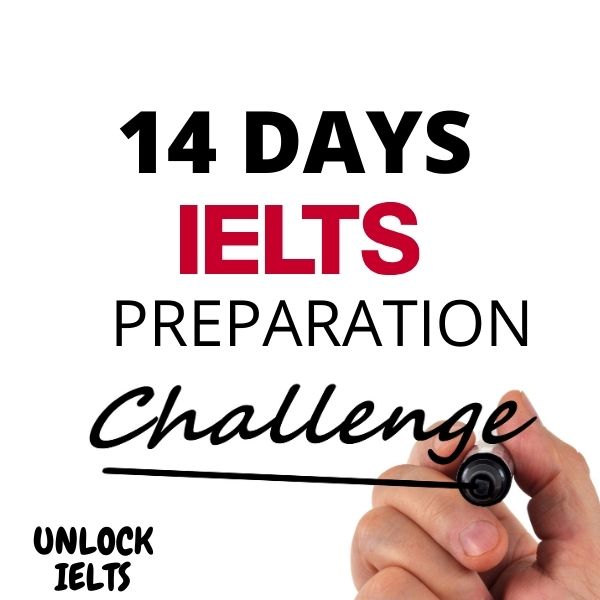
Related Posts

Last Day Strategies : IELTS Writing (Academics)

How to answer table chart essay in IELTS writing task 1 Academics

IELTS writing task 1 Academics: Understanding coherence and cohesion marking criteria

Understanding Task Achievement Marking criteria in IELTS writing task 1 Academics

How to answer line graph essay in IELTS writing task 1 Academics
Recent posts.

UnlockIelts- Designed for Your Success

Unlock your inner potential – How ‘Unlockielts’ makes it happen for you.

'Crushing The Curve': A Study Plan For Spectacular Results In Unlickielts Courses

'UnlockIELTS' Partner Program - Helping Others Meet Their English Language Goals!

Top 10 Myths About Preparing for the ILETS Exam Debunked

'Unlock' Your Score Today - Access Latest Tools and Techniques for Aceing IELTS Exam!
Frequently asked questions, 1) how to describe a pie chart sample, 2) how you can describe the percentages on a pie chart, 3) how to start an essay writing in the ielts, 4) how to write a description of the pie chart question, 5) how to prepare for the ielts from zero, of , how would you rate this course overall, write a public review.
- Richa Raj
IELTS Preparation with Liz: Free IELTS Tips and Lessons, 2024
- Test Information FAQ
- Band Scores
- IELTS Candidate Success Tips
- Computer IELTS: Pros & Cons
- How to Prepare
- Useful Links & Resources
- Recommended Books
- Writing Task 1
- Writing Task 2
- Speaking Part 1 Topics
- Speaking Part 2 Topics
- Speaking Part 3 Topics
- 100 Essay Questions
- On The Day Tips
- Top Results
- Advanced IELTS
How to Describe Pie Charts in IELTS Writing Task 1
Learn in easy steps how to describe IELTS Pie Charts for writing task 1. Below are easy techniques to help you write each paragraph: introduction, overview, body paragraph 1 and body paragraph 2.
Source: The above pie charts were not created by IELTS Liz.
Describing Pie Charts Step by Step
Below you will find easy to follow advice on how to describe your IELTS pie chart paragraph by paragraph.
Introduction
You must paraphrase the information given at the top of the charts “The graph shows the main sources of energy for the USA in 1980 and 1990”. You cannot copy this, you must use your own language.
- the graph = the pie chart
- shows = illustrates
- main sources of energy = energy production from different sources
- for the USA = don’t change this
- in 1980 and 1990 = in two different years (1980 and 1990)
The overview contains the key features of the charts. Answer the questions below to find the key features.
- What was the main source of energy in 1980?
- What was the main source of energy in 1990?
- Which produced the least energy in 1980?
- Which produced the least energy in 1990?
- Did the amount of energy produced by each source change a lot or just a little between the years?
- Did all types of energy increase by 1990?
Body Paragraph 1
This paragraph will give details about oil and hydroelectric power, which we highlighted in the overview above.
- You will need to write one sentence about oil comparing the percentage each year and then one sentence about hydroelectric power comparing the years.
- You must add data (percentages and dates) to support each sentence
Here are two example sentences. Fill in the gaps with the right words.
The amount of energy produced by oil in the USA 1. ………………. 42% in 1980 and this, then, 2. ………………….. to a third (33%) in 1990. The proportion of energy from hydroelectric power, 3………………, remained constant in both years ………a mere 5%.
- accounted for / comprised of / made up / was
- fell / declined / dropped / went down / decreased
- on the other hand / by contrast / in contrast ( we use a linker to highlight that this is opposing information to the previous sentence)
Body Paragraph 2
This paragraph will give detail about the other sources of energy in the pie charts.
- which sources increased?
- which sources decreased?
- what were the percentages for each source?
Again, fill in the gaps in these model sentences.
The energy generated by natural gas, which was the second 1. …………… source of energy in the USA in 1980, fell 2. ………. 1% to a quarter of all energy produced in 1990. In contrast, production by coal 3. ……………… from 22% to 27% in 1990 4. …………….. there was a 5% rise in energy from nuclear power to reach 10% in the second year.
- largest / major
- by (this is used when writing about differences in amounts)
- increased / rose / went up / climbed / grew
- while / whereas
Recommended Lessons
IELTS PIE Chart Model Practice Writing Task 1 Charts
……………………….
Free Subscribe to get new Posts by Email
Type your email…
Hi liz ,,, why did you use “while / whereas” to fill the fourth gap although the following information is not a contrast ? I mean both increased by 5% why you didnt use and instead of while ?
The words “while” and “whereas” are not only used as contrasts. They are also used for comparisons. Therefore, they are the perfect linking words to use when making comparisons. Always remember that many words in any language might have more than one meaning, more than one usage and much will depend on context.
The pie charts illustrate different sources of energy production for two different years (1980 and 1990) in America. The energy from different sectors are shown in perecentage.
It is apparent from the pie charts that oil constitutes the major source of energy in both the years , whereas hydroelectric power was the least source of energy for the two different years.The oil sector shows a decline in energy production in the next year whereas the hydroelectric power sector remained stable.
The energy generated by oil was 42% of the total energy in 1980 which then declined to a third of all energy generated in 1990. On the contrary , the hydroelectric power shares only 5% of the energy which remained to the same figure in the other year as well.
Natural gas was the second major energy generator with a share of 26% in 1980 which drops by 1% and became a quarter of all energy generated in 1990.Additionally coal and nuclear power which contributed to 22% ad 5% of all energy increased to 27% and 10% in 1990 respectively. (suggestions are welcome)
The pie chart unveils the information about the production of energy from various sources in USA in two years’ comparison (1980 and 1990).
Overall, the highest proportion of oil was being used to produce energy in both the years. Whereas, hydroelectric power was the least interested amongst all. There has also been a significant drop in producing energy from oil in ten years. Moreover, a considerable increase in coal and nuclear energy was noticed despite the drop in other categories.
In 1980, the oil constituted about two-fifths (42%) of the whole energy production which dropped to nearly one-third of the total in 1990. In opposite, hydroelectric power only produces 5% of energy in both the years (1980 and 1990).
The energy produced from natural gas covered nearly one in five (26%) of the whole in 1980. This figure was dropped by 1% only to a quarter of all energy produced in 1990. On the contrary, coal and nuclear power went up by 5% to 27% and 10%, respectively.
The pie chart illustrates the the changes in energy production from five different sources (oil, natural gas, hydroelectric power and nuclear power) for the USA in two different years(1980 and 1990).
Overall, it can be observed that in both years oil was used the most to produce energy, while hydroelectric power constituted the least energy. There was a slight decrease in the production from oil and natural gas, whereas an increase can be seen in the figures for coal and nuclear power.
In 1980, the percentage of power generation from oil and natural gas was 42% and 26% respectively. However these figures slightly dropped in 1990, with oil at mere 33% and natural gas at 25%.
Conversely, in the total amount of enegy production of 1980, coal and nuclear power contributed 22% and 5% respectively, while the contribution of each source increased by 5% which reached at 27% for coal and and at 10% for nuclear power in 1990. Remarkably, in both years, the same amount of enegery was produced from hydroelectric power (5%).
Hi Liz, I cannot thank you enough to show my gratitude on your work. Great job!
Regarding one phrase that stuck in my mind: “The energy generated by natural gas, which was the second major source of energy in the USA in 1980, fell by 1% to a quarter of all energy in 1990.” Here, we know that in 1980 natural gas constituted 26% of total energy generated but in 1990 it was 25%. However, we do not know that the change was by 1% as the we do not know the numbers. Overall, I wanted to be sure if we can describe the “weight” change in percentages like that.
thank you for your generosity! I can’t thank you enough. I have a questions regarding tenses. In scenarios like the task 1 here, should we stick to “past tense” when describing? Or we can simply use simple present tense since we are stating facts.
Your tense will depend on the data given. Data given in the past will require past tense. If not dates are given, you can use the present tense. And look out for any predictive graphs or charts which will require future forms.
The given pie chart delineates five main manufactures, namely oil, natural gas, coal, hydroelectric power and nuclear power, of energy for the United States of America in 1980 compared to 1990. Looking from an overall perspective, it is readily apparent that there were two downward trends in the proportion of natural gas and oil, while coal and nuclear power had upward trends in producing energy. The share of oil was below a half of energy in 1980, which is then decreased significantly by 9% from 42% to 33%. By contrast, natural gas produced 26% energy in 1980, then declined by 1% and accounted for the quarter of energy production in 1990. The energy generated by the proportion of coal underwent a considerable increase by 5% to 27% to over the quarter of the energy manufacturing. Hydroelectric power and nuclear power, on the other hand, were the same (5%) in 1980, however, the first one remained unchanged, whereas the latter rose by half to 10% in the USA.
I have one doubt about the phrase “the energy generated by natural gas in this example “, ‘energy’ is mentioned as an uncountable noun in your uncountable word list but here it is with the article ‘the’.
You are doing a great job by spending your valuable time and thank you so much for that.
Best wishes to you.
There are two articles “a” and “the”. The article “a” is never used with uncountable nouns because there are never one of them. For example, “traffic”, we do not say “a traffic” because there is no singular. However, the article “the” is not about numbers or counting how many there is. It is about whether the noun is defined or not. We can say “the traffic” which means we are referring to specific traffic. Please get my Grammar E-book to learn more about articles: https://elizabethferguson.podia.com/
The pie charts illustrates the percentage of energy produced from five different sources such as oil, natural gas, coal, hydroelectric power and nuclear power in the USA in two different years (1980 and 1990).
Overall, it can be seen that the main source of energy in 1980 and 1990 was through the use of oil whereas hydroelectric power produced the least energy. Similarly, there was a slight decrease in energy production from oil and natural gas while an increase can be seen in the figures for coal and nuclear power.
As seen in the graph, In the first year, the amount of energy produced from oil accounted for 42% of the total energy produced from different sources, however, this then decreased to 33% in 1990. Meanwhile the proportion of energy generated from hydroelectric power remained constant in both years.
Furthermore, nuclear power saw an increase in its energy production by 5% in the second year. Similarly, the amount of energy generated through the use of coal experienced a slight rise from 22% to 27% in that same year while natural gas which was the second largest source of energy in the USA, fell by 1%.
Thank you so much Ma’am…..it’s helps alot….extremely useful website😊
You’re welcome 🙂
The pie chart illustrates the percentage of five different forms of energy(oil, natural gas, coal, hydroelectric power and nuclear power) produced in the USA in two different years (1980 and 1990). Overall, it can be clearly seen that the most common form of energy was oil within the given period, even though there was a significant fall recorded in 1990. While more than half of the energy came from the two sources (oil and natural gas), the remaining only were generated from other sources (coal, hydroelectric power and nuclear power). Furthermore, it is worth to notice that there was no change in the share from hydroelectric power production. On the one hand, Oil and natural gas together occupied more than half of the total production of energy in the USA during 1980 and 1990. However, while there was a dramatic fall in oil energy, declining from 42% to 33%, production from natural gas decreased only slightly from 26% to 25%. In contrast, generation of energy from both coal and nuclear power had witnessed a significant rise by 5% (Coal- from 22% to 27%; Nuclear power- from 5% to 10%) while the hydroelectric power generation only remained stable with 5% on both the years.
Hey Teacher, First, I want to thank you endlessly for your efforts. Your lessons are useful. Please favour me with a small check to my essay for the example above.
The pie graphs illustrate different sources of energy production in the USA ( oil, natural gas, coal, hydroelectric power and nuclear power ) in the years 1980 and 1990.
Overall, at the beginning of the period the amount of energy produced from oil was the largest segment while coal and hydroelectric power made the lowest production. In comparaison, at the end of the period oil made up the biggest part of the chart as well. Meanwhile, production by hydroelectric power was the least significant of the main sources of energy for the USA.
The energy generated by coal accounted for 22% of the main sources of energy for USA in 1980 and had a moderate growth of 5% in 1990. That produced by nuclear power was 5% in the beginning of the period and experienced a twofold increase to one-tenth in the end of the period.
Energy from oil which comprised almost a half of the general energy produced in 1980, fell to 33% in1990. Furthermore in 1980, energetic outputs from natural gas ere at 26% and decreased slightly by 1% to a quarter of the main energy produced in 1990. However, the proportion of energy produced from hydroelectric power remained constant in both years at 5%.
Thanks Liz for all you do here.
Thanks Liza
Hello, Liz! I can’t help leaving a comment to express my gratitude and appreciation for your example. It makes it simple to teach how to write a report by merely following several steps.
Best wishes for you!
I’m so pleased it was useful 🙂
Hello Liz!Thank you very much for vivid explanation and clear ideas and clues about this type of task 1!I always was scared with pie-chart,but now im realised how to deal with them.Thank you!❤💕💗😘
I’m so glad you are more confident now. It’s just a matter of becoming more familiar with it all and have a clear approach 🙂
my exam is tomorrow and I’ve finally got the hang of the writing task 1. Thank you Liz! I do think my answer is a little verbose.
Good luck tomorrow! Keep your eye on the clock and manage your time properly.
Hi Liza thank you for your great page and priceless information.
Thank you so much mam Lots of love from Nepal😍😍
This was the best lesson and the best way to explain how to write a pie chart.Thank you so much Liz.
You are doing a great job. Your tips are really useful and your efforts are remarkable.
Hi Liz, you doing so good. thank you. but just a quick one, please are there no conclusion in writing task 1?
See the tips on this page: https://ieltsliz.com/ielts-writing-task-1-lessons-and-tips/
It was very easy to understand .thank u so much!!!
Thank you so much for your help while preparing for IELTS examination
See full model answers for writing task 1 on this page: https://ieltsliz.com/ielts-writing-task-1-lessons-and-tips/
Speak Your Mind Cancel reply
Notify me of new posts by email.
Advanced IELTS Lessons & E-books

Recent Lessons
Ielts liz personal update 2024, ielts model essay -two questions essay type, ielts bar chart of age groups 2024, ielts topic: urban planning, ielts listening transcripts: when and how to use them, 2024 ielts speaking part 1 topics.

Click Below to Learn:
- IELTS Test Information
Copyright Notice
Copyright © Elizabeth Ferguson, 2014 – 2024
All rights reserved.
Privacy Policy & Disclaimer
- Click here: Privacy Policy
- Click here: Disclaimer
Return to top of page
Copyright © 2024 · Prose on Genesis Framework · WordPress · Log in
IELTS Writing Task 1: How to Describe a Pie Chart

If you’re not sure where to start, don’t worry, we’ve got you covered. In this piece, we’ll give you an overview of how to describe an IELTS writing task pie chart, some specific IELTS writing pie chart tips, and some IELTS task 1 pie chart vocabulary. These strategies will help you score high on IELTS writing task 1 and earn a high band score overall.
We also recommend that you take a look the IELTS graph vocabulary guide , which covers useful language for IELTS writing task 1, including appropriate words and phrases.
How do pie charts work in IELTS Writing Taks 1?
A pie chart is a type of graph in which a circle is divided into sections, where each section represents a proportion of the whole. The various sections add up to 100%.

Sometimes you will see the pie charts illustrated as above, without any percentage marks. When this happens, you will need to approximate the amount. I like to think of the pie chart like a clock and imagine that the part where each section ends corresponds to the minute hand of the clock.
For example, in the pie chart above, you can imagine that the long hand falls on the 20-minute mark between “bus” and “walk,” which is a third of an hour. Therefore, the percentage of bus travel would be 33%. Likewise, the percentage of walking travel makes up the rest of the time before the clock hand reaches the 30-minute mark, so through some simple math, we can see that the walking travel is roughly 17%.
Rarely will you have just one pie chart. You will usually be presented with two or more pie charts or you might have both a pie chart and a graph that are related that need to be compared and contrasted. In each, though, there will be the following language: “Summarize the information by selecting and reporting the main features and make comparisons where relevant.”
Step-by-Step: How to Describe an IELTS Writing Task 1 Pie Chart
- Finally, remember that practice makes perfect. Use Magoosh IELTS prep lessons to not only improve your bar and pie chart descriptions, but to help increase your score across the test.
A Final Word on Describing IELTS Pie Charts
Remember that the in order to discuss a pie chart correctly, you will need to understand what exactly the graph shows. Make sure not to rush through reviewing the chart thoroughly, but also remember that you should only take about 20 minutes total on this IELTS writing task 1.
IELTS writing task 1 is short and straightforward, but a huge key to scoring well on the IELTS exam is having a good understanding of IELTS task 1 pie chart vocabulary. We hope this has been a helpful tutorial for this IELTS academic task!

Eliot Friesen-Meyers is the Senior Curriculum Manager for Magoosh IELTS and TOEFL. He attended Goshen College (B.A.), New York University (M.A.), and Harvard University (M.T.S.), gaining experience and skills in curriculum development, ESOL instruction, online teaching and learning, and IELTS and TOEFL test prep education. Eliot’s teaching career started with Literacy Americorps in Pittsburgh, Pennsylvania, and later, taught ESL programs at Northeastern University, University of California-Irvine, and Harold Washington College. Eliot was also a speaker at the 2019 TESOL International Conference . With over 10 years of experience, he understands the challenges students face and loves helping them overcome those challenges. Come join Eliot on Youtube , Facebook , and Instagram . Recent blog posts Complete Guide to IELTS Writing Task 1 Complete Guide to IELTS Writing Task 2
View all posts
More from Magoosh

2 responses to “IELTS Writing Task 1: How to Describe a Pie Chart”
Where is the answer of the bar graph?
There is no specific “answer” to these charts. Is there a direct question you want to ask about how you might frame a response to these?
Leave a Reply Cancel reply
Your email address will not be published. Required fields are marked *
Free IELTS lessons signup

- Academic practice
- General practice
- Task 1 Academic
- Task 1 General
- Task 2 (essay)
IELTS Academic Writing Task 1. Sample 1
You should spend about 20 minutes on this task.
The pie graphs below show the result of a survey of children's activities. The first graph shows the cultural and leisure activities that boys participate in, whereas the second graph shows the activities in which the girls participate.
Write a report describing the information shown in the two pie graphs.
Write at least 150 words.
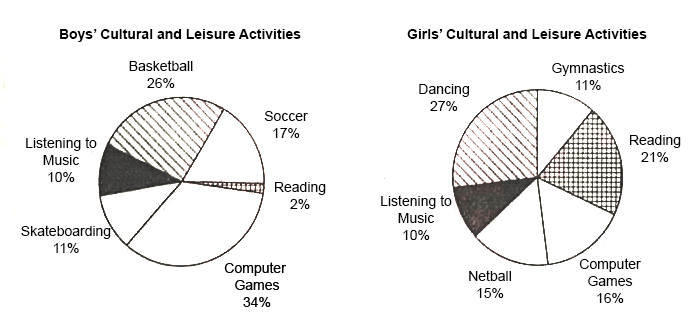
How to answer this task?
Introduce the pie charts.
Write what do they summarize.
Write a general overview.
Write in brief the main trends.
Describe the first chart.
Tell about the activities on the boys' chart and their popularity. Use linking structures and vocabulary to describe graphs .
Describe the second chart.
Tell about the activities on the girls' chart and their popularity. Use words from academic wordlist .
Model answer
The two pie charts draw the conclusion of a survey of boys' and girls' cultural and leisure activities.
Overall, equal quantities of both sexes enjoyed listening to music, but a dramatically larger number of girls liked reading. There were also many differences in terms of the children's preferred sports.
Turning to the first chart, we can observe that boys prefer playing computer games (34% participation rate) than taking other activities. Playing basketball comes as the second most popular leisure, practiced by almost a third of male children. Basketball is followed by soccer, which is exercised by 17%. Skateboarding and listening to music are less preferable activities, chosen by 11% and 10% of boys respectively. Reading, the least popular cultural activity among boys, represents only two percent.
Taking a closer look at the second chart, we can see that girls' most preferred activity is dancing, being 27% of the total. In contrast to the boys' preferences, reading is chosen by more than a fifth of all girls. Although percentage of female children who play computer games is roughly twice less than that of boys (16%), this activity is third most popular on the girls' chart. With a slight difference between computer games and netball, the latter is practiced at 15% rate. Similarly to skateboarding popularity among boys, 11% of girls go in for gymnastics. Listening to music comes as the least popular leisure, with a proportion of 10%, equal to those on the first chart.
(244 words)
- A Beginner’s Guide to IELTS
- Common Grammar Mistakes [for IELTS Writing Candidates]
Writing Correction Service
- Free IELTS Resources
- Practice Speaking Test
Select Page
How to Describe Pie Charts [IELTS Writing Task 1]
Posted by David S. Wills | Apr 12, 2021 | IELTS Tips , Writing | 0
In task 1 of the IELTS writing test, you may be given one or several pie charts to describe. You will be required to write at least 150 words discussing those pie charts and (sometimes) how they relate to tables or other types of data. In this lesson, I will show you how to describe pie charts by giving you tips on vocabulary, grammar, and content.
If you want to boost your IELTS writing score quickly and effectively, you might be interested in my writing correction service .
How to Describe Pie Charts for IELTS Writing Task 1
First of all, we need to understand what the purpose of IELTS writing task 1 is. Basically, for this part of the test, you are required to describe some sort of data. This could be any of the following:
- Process diagram
The whole purpose is to test your ability at writing concise and accurate descriptions. This is very different from task 2, where you need to write an essay that discusses or argues something.
The three main aspects of task 1 are:
- Understanding the data
- Describing it accurately
- Grouping it effectively
This means that when you are given a pie chart (or several), then you will need to interpret it correctly and then write a short report in precise English that can be easily understood by the examiner.
That’s all there is to it. There are no tricks or tips or magical things you can do.
Now let’s look in a little more detail at how to do this properly.
Understanding Pie Charts for Task 1
A task 1 pie chart will more than likely be presented in two forms. Either you will be given one pie chart and some other form of data (line graph, table, etc) or you will be given several pie charts. The reason is that IELTS writing task 1 requires comparing and contrasting data. If you just had one single pie chart, there really would not be much to say about it.
Let’s look at some examples:
Here, you can see that we have two pie charts to compare. The important thing here would be to compare the differences over time.
Here again we have two pie charts, but this time we are not looking at differences over time. Instead, we are comparing two different countries. This requires different grammatical skills.
Now there are four pie charts! This sort of task would take more thought in the beginning, but actually it is not much harder to answer.
Finally, we have a mixture of a table and two pie charts. Actually, it is probably more common to say a table and one pie chart, but in this case there are two.
Pie Chart Vocabulary
There is really no special language that you need to know in order to describe pie charts. There are no unique features that require unusual vocabulary. Instead, you need a good knowledge of language that would also help you for line graphs, tables, and so on.
Perhaps the two most important words are “percentage” and “proportion.” This is because pie charts do not show a specific amount (dollars, kilograms, etc) but instead they show the proportion of something.
Thus, in descriptions of pie charts, you will frequently see the phrases:
- the percentage of…
- the proportion of…
Because pie charts contain this sort of data, they will invariably have many numbers for you to talk about. You should avoid using too many numbers (see this article for more information about describing numbers) and instead you should vary your language:
If you can do this effectively, you can avoid including too many numbers. This can make your essay look and sound better.
Some more advanced phrases:
Remember that you can also make your language more specific with adjectives, saying “a very small proportion” or “a tiny percentage of…”
Grammar for Pie Charts
Of course, it is not just vocabulary that is important when it comes to IELTS writing. In fact, grammar is far more important in many respects. When it comes to IELTS writing task 1, people really overlook the significance of accurate grammar.
First of all, you need to assess when the data took place or was gathered. Presumably it was in the past, but that is not always the case. Sometimes a pie chart will contain speculative data about the future. You need to choose the right verb form for an accurate description.
Many times, past simple will be the correct tense to use. You can say things like:
- In 1994, a quarter of people said that…
- In the first year, nearly half of shops made a profit…
However, we need to be aware that pie charts can show changes over time. This is true if there are two or three pie charts:
- In 1998, that number had dropped by six percent…
- Four years later, the proportion of bankrupt businesses had soared to…
In these cases, we have used past perfect because this accurately reflects changes between points of time in the past. We can pick one time and look further into the past from then.
Grouping Data for Pie Charts
Some people find that it is really difficult to group data effectively in IELTS. Sometimes it is hard because of a particular question but sometimes it can be much easier. You just need to think logically and make some choices.
To be honest, in most cases I would divide the data chronologically, which means “by time.” If you have a pie chart from 1991 and another from 2001, I would devote one paragraph to the first year and one to the second year. You can give a description of the first year and then in the next paragraph give some comparative details.
However, that is not the only way to approach it. You might also find it useful to break down the data by category if that is appropriate.
If there is a pie chart and a table, it might also be appropriate to deal with the pie chart in one paragraph and the table in another. It totally depends on the context.
You can read more about structuring task 1 essays here .
Sample Answers
Ok, now let’s explore further by looking at some sample band 9 answers.
Sample Answer #1 – online retail sales
There are two pie charts showing data about online shopping in Canada in two different years, 2005 and 2010. The data is divided between the various types of goods sold online, with four retail sectors represented, and there were some notable changes during the five-year period.
In 2005, electronics and appliances were the most commonly sold items, making up a third of Canadian online sales. Home furnishings came next with a quarter of the total, and this was followed by food and beverage and then video games, each with roughly a fifth of the total online sales.
By 2010, this had all changed. Food and beverages were now the highest selling items online, while electronics and appliances had slipped into second place, having dropped by five percent. Home furnishings had dropped from second to last place, and video games sales had increased so that they now made up 23% of all online shopping.
First of all, let’s point out that I have changed the formatting of the labels on this task. That’s really important! Many people just copy them into their essays, but actually one of the challenges of IELTS is changing labels or titles into proper grammar.
Next, notice that my introduction is in the present tenses and my body paragraphs use appropriate past tenses. This is because the first paragraph looks at the pie charts on the piece of paper in front of me whilst the next paragraphs examine the data that comes from the past.
How many numbers have I used here? Just one! I only say “23%” in the final line. Prior to that, I used phrases like “a third” and “second place.” This shows off my English rather than just repeating numbers, which tells the examiner nothing.
Sample Answer #2 – pie charts about education
These two pie charts give information about the highest levels of education attained by people in two different countries, with data drawn from people aged over twenty-one. In both nations, secondary school was the highest level of qualification achieved by the largest number of people.
In country A, 45% of people had secondary school as their highest level of education, compared to 35% in country B. Notably, both nations had exactly 30% of people giving vocational or technical school as their highest educational qualification. In this respect, the two countries were quite similar.
However, in country B, a quarter of the population had attended university, compared to just 5% in country A. Conversely, in country A it was much more likely that people had attended primary school as their highest level of education. In both nations, just 5% of the population had not gotten any form of education at all.
This essay uses more numbers but not too many. The grammar here is accurate but it is based upon an assumption that I have made – that the data is from the past. Of course, it could not be from the future and it is unlikely to reflect the present. However, you could theoretically describe this with the present simple tense.
Notice my structure: I have discussed both countries within each body paragraph. I did this in order to highlight differences more effectively. I thought that if I described one pie chart and then another, it would not be so obvious how they differed.
Sample Answer #3 – four pie charts about electricity
There are four pie charts that give information about the generation of electricity in France and Germany in the year 2009. One set of charts looks at the total generation of electricity, while the other looks at how renewable forms of energy were produced. The two countries had roughly similar amounts of renewable energy, but these came from totally different sources.
Almost six tenths of German electricity came from conventional thermal sources, with almost a quarter coming from nuclear power. In France, however, about three quarters came from nuclear power and just a tenth came from conventional thermal. Both countries had similar figures for renewable sources – 17.4% for Germany and 13.7% for France.
In terms of different renewable energy sources, Germany relied primarily upon biomass, with forty percent of its renewable energy from that source, compared to less than a tenth for France. More than eighty percent of French renewables came from hydropower, compared to less than a fifth in Germany. About a third of German renewable energy came from wind, while the figure was just a tenth in France, and both countries produced very little solar power.
Here we have four pie charts. It is important first of all to divide them into two different countries and then to understand that the pie charts on the right are subsets of the pie charts on the left. If you failed to realise this, your description would not be accurate.
Notice again that I have avoided an over reliance upon numbers by converting these into fractions like this: “Almost six tenths of German electricity…”
I have devoted one paragraph to the first set of pie charts (overall energy) and the next paragraph to the renewable section. This allows me to effectively compare and contrast the two countries.
Sample Answer #4 – tables and pie charts together
There is a table that gives the numbers of visitors to a museum before and after its renovation, as well as two pie charts that show details about visitor satisfaction. After refurbishment, the museum received many more visitors and they were much more satisfied with their visits.
In the year before the museum was renovated, there were 74,000 visitors, and in the year after that number soared to 92,000. Prior to this work being done, a half of all visitors were unhappy with the museum. According to the survey, forty percent of them were dissatisfied and a tenth were very dissatisfied. Only 45% seemed to have enjoyed their visit.
In the year following the museum’s refurbishment, visitors reported much more positive feelings towards their visits. The number of people who were unhappy with their museum visit dropped by a half, with those who were very dissatisfied falling to just 5% and only 15% of them now claiming to be dissatisfied. Three quarters of all visitors were at least satisfied.
In each survey, 5% of people gave no response.
This essay may look a little odd at first glance. The final paragraph is extremely short and normally I would advise against that, but in this instance it was fine because the data was relevant enough to include but not really connected to anything else, so it would have been strange within another paragraph. I also had to consider how to incorporate the data from the table, which certainly did not warrant a paragraph of its own. You can see that I slotted it into the second paragraph.
In order to describe this data effectively, I have combined some categories. The pie chart categorised people as “very satisfied” and “satisfied” but for the sake of simplicity I have put them together. This is ok as long as it is clear to your reader what you are doing. In this case, I achieved that by saying things like “Three quarters of all visitors were at least satisfied.”
If you want to learn more about pie charts, you can read the Wikipedia page for some ideas. This might help you to pick up some new language or see how different types of pie charts look.
About The Author
David S. Wills
David S. Wills is the author of Scientologist! William S. Burroughs and the 'Weird Cult' and the founder/editor of Beatdom literary journal. He lives and works in rural Cambodia and loves to travel. He has worked as an IELTS tutor since 2010, has completed both TEFL and CELTA courses, and has a certificate from Cambridge for Teaching Writing. David has worked in many different countries, and for several years designed a writing course for the University of Worcester. In 2018, he wrote the popular IELTS handbook, Grammar for IELTS Writing and he has since written two other books about IELTS. His other IELTS website is called IELTS Teaching.
Related Posts
5 ways to improve your pronunciation for IELTS at home
May 14, 2018
How to Write an Essay Outline [IELTS Writing]
June 6, 2022
Get a FREE handbook for IELTS grammar
March 14, 2018
- How to Improve your IELTS Writing Score
April 15, 2024
Leave a reply Cancel reply
Your email address will not be published. Required fields are marked *
This site uses Akismet to reduce spam. Learn how your comment data is processed .
Download my IELTS Books
Recent Posts
- Past Simple vs Past Perfect
- Complex Sentences
- How to Score Band 9 [Video Lesson]
- Taxing Fast Food: Model IELTS Essay
Recent Comments
- David S. Wills on How to Describe Tables for IELTS Writing Task 1
- anonymous on How to Describe Tables for IELTS Writing Task 1
- David S. Wills on Writing Correction Service
- James Oluwasegun on Writing Correction Service
- Daisey Lachut on IELTS Discussion Essays [Discuss Both Views/Sides]
- Lesson Plans
- Model Essays
- TED Video Lessons
- Weekly Roundup

IELTS Writing Task 1: Cambridge 14 Test 1, three pie charts; analysis of candidate’s answer, strategies & a band 8+ sample answer
In this IELTS Writing Task 1 post, we are going to have a look at an Academic Writing Task 1 question from Cambridge IELTS Series 14 , the latest publication of Cambridge IELTS Series. IELTS candidates will find an analysis of the 6.5 grade model answer for these three pie charts combined in the last part of the book for this question and then an attempt to make the answer a better one which can be graded a far greater band-score. This post is intended to guide IELTS learners and candidates to gather a better idea about Writing Task 1.
Cambridge IELTS 14 Test 1 Writing Task 1: Three pie charts on nutrients in American meals
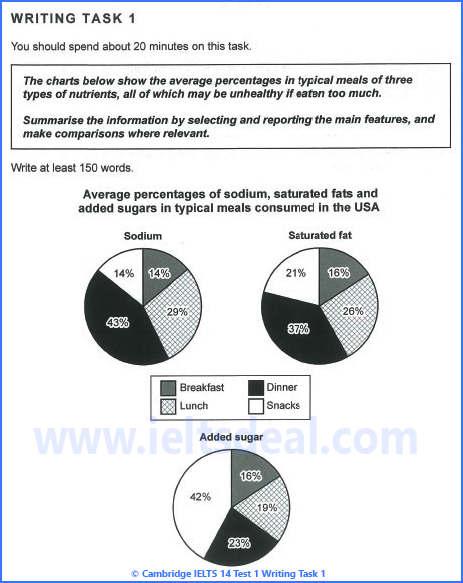
As you can see, this is a pie chart question where some datum are given on the percentage of nutrition values in three nutrients found in four typical or classic USA meals, namely breakfast , lunch , dinner and snacks . The meals are separated in each pie chart using different colour patterns. We have three pie charts here; the first one representing Sodium , the second one for Saturated fat and the third one symbolizing Added sugar .
In this post, first we’re going to analyse the sample answer written by a candidate provided in the last part of the book which was awarded a 6.5 band-score.
Here’s the sample answer:
The diagrams illustrate the average proportions of three types of nutrients in typical meals, which can be unhealthy if consumed too much. The three types include sodium, saturated fats and added sugar. The data is taken from the United States of America.
The first chart shows the average percentages of sodium. Dinner contains the most sodium (43%). Breakfast and snacks include an equal proportion of sodium consumed, with each of them adding up 14% of sodium. Through eating lunch, 29% sodium is consumed. The second chart shows the percentage of saturated fat in meals. By eating dinner, 37% saturated fat is consumed. Lunch contributes to a consumption of 26% saturated fat, followed by snacks with 21% and breakfast with 16%.The last chart illustrates the proportions of added sugar. Snacks contain the highest amount of added sugar (42%). Dinner includes 23% A typical dinner includes 23% added sugar, while lunch contains 19% and breakfast includes 16%.
All in all, the diagrams show that every typical meal consumed in the USA contains a percentage of at least 14% of nutrients that can be unhealthy is eaten too much.
- Now let’s have a look at what the examiner has to say about this 6.5 band-score answer:
Here is the examiner’s comment:
The candidate has accurately reported the data for each chart and has presented a summary of the information, but could achieve a higher score by making comparisons across the charts, e.g. breakfast contains the lowest amounts of sodium, saturated fats and added sugar. The information is logically organised and there is a clear progression throughout the script. The main points are clearly signaled [ The first chart | The second chart | All in all ] and there are examples of other cohesive devices [ each of them ]. The range of vocabulary is varied [ data | contains | an equal proportion of | consumed | consumption | illustrates ]. Minor errors do not cause misunderstanding [ adding up 14% of sodium ]. There is a mix of simple and complex sentence structure, using active, passive and modal verb forms and there is also subordination through the use of participles [ Through eating lunch | By eating dinner | followed by ]. More variety in grammatical structures would perhaps achieve a higher score.
Here’s how I’ve analysed this model answer and prepared a better answer:
Most of the experts in IELTS convey that a Task 1 report should have the introduction and the summary/overall trend/ general trend in the beginning of the answer. This is because the examiner always expects to gather a great impression about the candidate to score him/her better than others and the best way to get that impression is by producing a striking INTRODUCTION.
A striking introduction to a Task 1 report is produced in the following way using 2 sentences:
Sentence no. 1: Paraphrase the question title using some uncommon vocabulary but do not write too extravagant words. Keep it simple but decorate the sentence with some eye-catching and relevant words.
Sentence no. 2: Present an overview/summary/overall trend/general trend right after the introductory sentence. Remember, you are giving a summarized picture of all the information combined in the TASK 1 illustrations/diagrams/charts/tables/graphs. So, never put down any personal comments such as reasons or effects or any personal opinion.
The provided sample answer has two problems here:
First, the introduction is in three sentences which could have been written in only one sentence . Take a look:
Second, the overview is given at the end , after the description or body paragraph. Additionally, the candidate has also repeated the line ‘ can be unhealthy is eaten too much’ in the summary which has already been mentioned earlier in the introduction.
This could have been written right after the introduction .
The candidate could write like the following band score 8+ example introduction and summary :
The average proportions of three types of nutrients such as sodium, saturated fats and added sugar in typical American meals are compared in the depicted charts which may be detrimental to health if consumed excessively.
Overall, the charts clearly show that dinner and snacks contain more saturated fats and added sugar compared to breakfast and lunch which make the former meals unhealthier than the latter ones.
Now, let’s have a look at the body paragraph/description of the candidate’s answer and analyse it to find out the problems:
The first chart shows the average percentages of sodium. Dinner contains the most sodium (43%). Breakfast and snacks include an equal proportion of sodium consumed, with each of them adding up 14% of sodium . Through eating lunch, 29% sodium is consumed. The second chart shows the percentage of saturated fat in meals. By eating dinner, 37% saturated fat is consumed. Lunch contributes to a consumption of 26% saturated fat, followed by snacks with 21% and breakfast with 16%. The last chart illustrates the proportions of added sugar. Snacks contain the highest amount of added sugar (42%). Dinner includes 23% A typical dinner includes 23% added sugar, while lunch contains 19% and breakfast includes 16%.
- Here, in the description, the major problem is that we don’t find a good amount of comparison among the different types, and this problem contributed to the lower score. The candidate should have tried comparing between two types of meals taken by US people and show the difference of same nutrients.
- The candidate’s description doesn’t contain much sentence errors (except for with each of them adding up 14% of sodium ). He could have written “Breakfast and snacks include an equal proportion of sodium which is 14%.”
- The answer also contains good usage of cohesive devices/linkers/connectors but it could have been better and that would have made the answer stand out.
Here’s a band 8+ model description that you can use:
The first chart, that presents the average rates of sodium, depicts that dinner contains the highest proportion of sodium (43%) while lunch is in the second position with 29%. Both breakfast and snacks include an equal proportion of sodium (14%) which is the lowest amount for this type of nutrient. The chart showing the rates of saturated fats display nearly the similar account of sodium. Here, dinner contains the maximum and breakfast holds the minimum amount of saturated fats. Lunch has 26% fats but snacks have 5% saturated fats less than lunch. In the third chart, snacks offer quite a contradictory picture as they contribute to the consumption of 42% added sugar which makes this type of meal the most vulnerable. Additionally, the Americans consume 23% added sugar by taking their dinner which is 4% higher than lunch and 6% more than breakfast.
This is how you can describe the charts by showing a good number comparison using simple, complex and compound sentences. I’ve also used both active and passive sentences here. I’ve used some synonyms such as present, show, depict, display, offer, etc. I’ve also used different synonyms for eat ( take, consume etc.). The use of cohesive devices is ample in the introduction, summary and description, and so the answer flows smoothly.
Here’s the complete band 8+ answer for you:
Word count: 209
N.B.: You need not use three paragraphs for all Task 1 answers. I’ve used an extra paragraph to show the summary/ overview/ overall trend because it is nearly of the same size of the introduction.
Click here for learning about cohesive devices/connectors/linkers/connecting words
5 thoughts on “ IELTS Writing Task 1: Cambridge 14 Test 1, three pie charts; analysis of candidate’s answer, strategies & a band 8+ sample answer ”
I’ve found this article pretty useful, because I was able to compare both Sample answers for a band 6,5 and 8+ with my own essay and understood my own mistakes.But,I would be even happier if Mr. Rasul could check my essay.
Dear Muzaffarjon,
It will be my pleasure to check your writings.
Please, send me a mail to know more about the service or follow this link: http://ieltsdeal.com/ielts-writing-correction-service-get-your-writings-checked-and-improve-further-to-higher-scores/
The charts illustrate average percentages in food meals of three kinds of nutrients, all of them can be bad for reported Americans. Overview, details show that the Americans consume mostly sodium (43 percentage ) and saturated fat ( 37 percentage ) for dinner. Meanwhile added sugar is also consumed for the dinner but in a smaller percentage of 23. Looking from the charts results we can see that for lunch we have almost equal percentages in consuming sodium (29 %) and saturated fat (26%). Added sugar have again smaller percentages (19%). Americans almost use the same amount of three nutritions for the breakfast. Rapidly change happends for snacks. Here the main nutrition is added sugar (42 percentage ), following the saturated fat (21 percentage) and the last is sodium (14 percentage). All in all, the charts details us that consuming each nutritions in bigger amounts can be very damaging for health. We may consider that healthy life- style needs to be in balance between all meals of the day. Can You please help me with rating this ?
at present i can doo ielts exam of reading module can u plss make all others modules like acadimic 15 , 16 etc or if there pls send to mail
The pie charts compare the proportions of sodium, saturated fat and added sugar in four kinds of American meals. Overall, dinner and snacks constituted the highest percentages of saturated fats and added sugars, whereas breakfast and lunch had the lowest proportion of these nutrients. Looking at the first chart, dinner contains more than two-fifths of sodium (43%), while lunch is in the second position at 29%. By contrast, breakfast and snacks account for the smallest amount of sodium at 14% each. In terms of saturated fats, dinner and lunch hold the highest numbers of this nutrient at 37% and 26% respectively. The figures for snacks and breakfast have roughly 5% and 10% saturated fats less than lunch. In the USA the four types of American meals also contain a higher number of added sugars. Just under half is found in snacks, followed by less than a quarter (23%) at dinner. On the other hand, added sugar proportions for breakfast and lunch are below 20% and the difference between them is around 3%.
Leave a Reply Cancel reply
Your email address will not be published. Required fields are marked *

IELTS Writing Task 2: Agree disagree topic on using forensics to solve old cases; with 3 model answers
This IELTS Writing Task 2 post offers some sample answers to an agree-disagree topic. This agree-disagree topic asks the candidates to provide arguments as to whether new science related to criminal forensics should be used to look at old cases or not. In this post, you will find three great model answers which may help […]

IELTS Writing Task 2: an advantage-disadvantage essay on taking a gap year before starting university education; with plans and model answer
This IELTS Writing Task 2 post offers the insights of writing a great answer to an advantage-disadvantage essay. This task 2 question asks the candidates to provide their personal opinions on taking a gap year before starting university education. In this post, you will find a plan that can help you to write this answer […]
CHARTS AND GRAPHS ESSAY EXAMPLES
IELTS Writing Task 1 Academic Charts And Graphs Essay Examples
View High Band Score Examples Of IELTS Writing Task 1 Academic Charts And Graphs Essays
IELTS Writing Task 1 – Table Essay Example 3
IELTS Writing Task 1 Academic table essay example that is a band score 8. The question is: The table below gives information about the problems faced by children in two primary schools in 2005 and 2015. Take a look at the sample answer
IELTS Writing Task 1 – Table Essay Example 2
IELTS Writing Task 1 Academic table essay example that is a band score 8. The question is : The table illustrates the proportion of monthly household income five European countries spend on food and drink, housing, clothing, and entertainment. Take a look at the sample answer.
IELTS Writing Task 1 – Table Essay Example 1
IELTS Writing Task 1 Academic table essay example that is a band score 8. The question is: The following table gives statistics showing the aspects of quality of life in five countries. Take a look at the sample answer.
IELTS Writing Task 1 – Pie Chart Example Essay 1
IELTS Writing Task 1 Academic pie chart essay example that is a band score 8. The question is: The chart below shows how much money is spent in the budget on different sectors by the UAE government in 2000. Take a look at the sample answer.
IELTS Writing Task 1 – Line Graph Essay Example 2
IELTS Writing Task 1 Academic line graph essay example that is a band score 8. The question is: The line graph illustrates the amount of spreads consumed from 1981 to 2007, in grams. Take a look at the sample answer.
IELTS Writing Task 1 – Line Graph Essay 1
IELTS Writing Task 1 Academic line graph essay example that is a band score 8. The question is: The line graph below shows changes in the amount and type of fast food consumed by Australian teenagers from 1975 to 2000. Take a look at the sample answer.
IELTS Writing Task 1 – Bar Chart Example Essay 3
IELTS Writing Task 1 Academic bar chart essay example that is a band score 8. The question is: The chart shows the percentage of drugs taken by girls and boys in a school in New Zealand. Take a look at the sample answer.
IELTS Writing Task 1 – Bar Chart Example Essay – 2
IELTS Writing Task 1 Academic bar chart essay example that is a band score 8. The question is: The chart below shows the number of men and women in further education in Britain in three periods and whether they were studying full time or part-time. Take a look at the sample answer.
IELTS Writing Task 1 – Bar Chart Essay Example 1
IELTS Writing Task 1 Academic bar chart essay example that is a band score 8. The question is: The chart below gives information about Someland’s main exports in 2005, 2015, and future projections for 2025. Take a look at the sample answer.
Related Posts

IELTS Discussion Essay Sample 2 – Economics
IELTS Writing Task 2 discussion essay example that is a band score 8. The question…
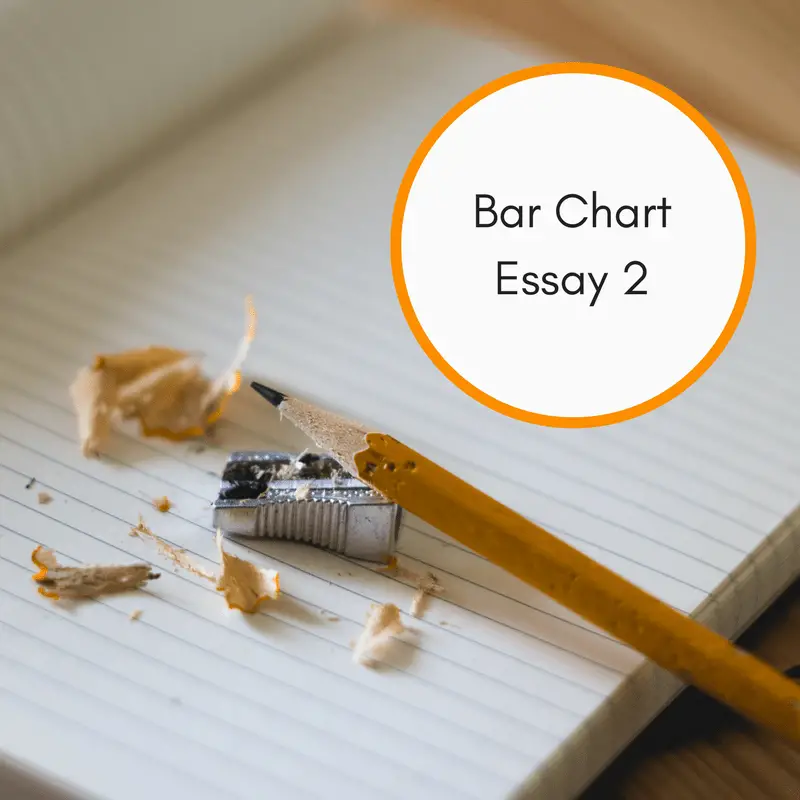
IELTS Writing Task 1 Academic bar chart essay example that is a band score 8.…

IMAGES
VIDEO
COMMENTS
Using this 5 steps process to plan and write IELTS pie chart essays will help you to achieve high marks in Task 1: 1) Analyse the question. 2) Identify the main features. 3) Write an introduction. 4) Write an overview. 5) Write the details paragraphs. In this lesson, we're going to work thorough each step as we answer a practice question and ...
Look at the pie chart, exam question and sample answer and do the exercises to improve your writing ... Writing about a pie chart - essay 483.32 KB. Writing about a pie chart - writing practice 227.58 ... This pie chart show the information how people prefer to access the internet with their devices. The devices are shown in red, blue, green ...
We will first look at an example question where one pie chart is provided. ... Come back to this lesson to check the model essay and analysis. Model Essay. The charts below provide information on popular modes of transport in the city of Cambridge for the years 2008 and 2018. Summarise the information by selecting and reporting the main ...
Pie Chart Sample Answer. The two pie charts illustrate the proportion of five sources of energy production in France in 1995 and 2005. ... An in-depth analysis of the energy production in 1995 shows that Coal (29.8%), Gas (29.63%), and Petrol (29.27%) were all almost equally produced whereas the production of nuclear energy and other types of ...
Make Notes about Figures. In the charts below you can see I've followed the charts for each of the five fields from 1981 via. (through) 1991 to 2001, and drawn an arrow to show the overall trends and calculated the overall changes. For example, Insurance went from 2% to 3% to 8% so that is a clear upward trend, so I made a note on the final ...
Task 1 Sample. You should spend about 20 minutes on this task. The pie chart shows the amount of money that a children's charity located in the USA spent and received in one year, 2016. Summarise the information by selecting and reporting the main features and make comparisons where relevant. Write at least 150 words.
Take a look at the IELTS Writing Task 1 Academic essay example below >>. *This pie chart question and answer were provided by a student. IELTS Achieve did not design this question*. The chart below shows how much money is spent in the budget on different sectors by the UAE government in 2000. Summarize the information by selecting and reporting ...
Model IELTS Academic Writing Task 1 Prompt: Pie Chart. The chart below gives information about the household percentage of spending on essential goods in China for the years 1995 and 2011. Summarise the information by selecting and reporting the main features and make comparisons where relevant. The two pie graphs show differences in Chinese ...
Here is a sample answer for the IELTS pie chart task. Go through them to understand how to describe a pie chart in the IELTS writing task 1. Ans: The pie charts represent the ratio of the five major types of energy production in France in 1995 and 2005.
View a sample pie chart for the IELTS test on electricity generation, with a model answer. In a pie chart you have to use language connected to proportions and percentages. ... Decreasing House Sizes Essay . Apr 06, 24 10:22 AM. In this decreasing house sizes essay for IELTS you have to discuss the pros and cons of smaller house sizes and gardens.
Model Answer for a Pie Chart. This pie chart shows the shares of total world food consumption held by each of seven different food types in 2014. Meat is consumed the most, at 31.4 per cent. Fish has the second-highest consumption levels, at 27.9 per cent. Cereals consumption represents 11.7 per cent of the total.
Watch on. Pie chart is one of the major questions in IELTS academic writing task 1. Under this, you are expected to write your answer as a response to the pie chart presented. Here, you are required to describe the information given in 150 words in 20minutes. To score well in the pie chart essay questions, you need to study the question well.
Introduction. You must paraphrase the information given at the top of the charts "The graph shows the main sources of energy for the USA in 1980 and 1990". You cannot copy this, you must use your own language. Tips. the graph = the pie chart. shows = illustrates. main sources of energy = energy production from different sources.
The IELTS Academic Writing Task 1 essay has you write a 150-word report about a bar chart (also known as a bar graph), a process diagram, a table, line graph, or a pie chart. ... Example IELTS Academic Pie Chart. Sometimes you will see the pie charts illustrated as above, without any percentage marks. When this happens, you will need to ...
IELTS Academic Writing Task 1. Sample 1. You should spend about 20 minutes on this task. The pie graphs below show the result of a survey of children's activities. The first graph shows the cultural and leisure activities that boys participate in, whereas the second graph shows the activities in which the girls participate.
IELTS Writing Task 1 Academic Sample (Pie Chart), Band 9. The charts below show the proportion of the energy produced from different sources in a country between 1985 and 2003. Summarize the information by selecting and reporting the main features, and make comparisons where relevant. The given pie charts compare the percentage of energy ...
The three main aspects of task 1 are: Understanding the data. Describing it accurately. Grouping it effectively. This means that when you are given a pie chart (or several), then you will need to interpret it correctly and then write a short report in precise English that can be easily understood by the examiner.
Use pie charts to compare the sizes of categories to the entire dataset. To create a pie chart, you must have a categorical variable that divides your data into groups. These graphs consist of a circle (i.e., the pie) with slices representing subgroups. The size of each slice is proportional to the relative size of each category out of the whole.
Try doing a Google image search for 'pie charts' and you'll find plenty of charts that you could practise describing. Here's one I found: To write an essay, you need to do 3 things: Introduce the chart by saying what it shows. Summarise the information by describing the main/general points. Describe the charts in detail, comparing the figures (2 paragraphs).
IELTS writing task 1 pie chart sample essays. Cookie Duration Description; cookielawinfo-checkbox-analytics: 11 months: This cookie is set by GDPR Cookie Consent plugin.
Explore IELTS Writing Task 1 with a detailed analysis of a candidate's answer to three pie charts from Cambridge 14 Test 1. Discover effective strategies and access a band 8+ sample answer to excel in your writing. Enhance your IELTS preparation with valuable insights and boost your chances of success in the Writing Task 1 section.
IELTS Writing Task 1 - Bar Chart Essay Example 1. IELTS Writing Task 1 Academic bar chart essay example that is a band score 8. The question is: The chart below gives information about Someland's main exports in 2005, 2015, and future projections for 2025. Take a look at the sample answer. View high band score examples of IELTS writing task ...
Example 1 The 2D pie chart is a simple circle divided into sectors to represent each category in a dataset. We use this type of pie chart to visually compare the share of categories as part of the whole. The example below shows a 2D pie chart that visually depicts the market share of web servers: Apache (44.46%), Microsoft (30.1%), Zeus (0.02% ...